#German invasion of Greece
Text

Panzer II fording a river in Greece, 1941
#panzer ii#tanks#german armor#german tanks#german invasion of greece#balkans campaign#mediterranean theater
58 notes
·
View notes
Text
Clive Dunn, as he is now better known, will for many people always be Corporal Jones, Dad's Army excitable veteran of imperial wars, but in 1941 he was just twenty-one and a stretcher-bearer and orderly for Captain Eden (cousin of Anthony). He had been on the run for weeks and was frail and suffering from dysentery when he was captured. Although the Germans who caught him were friendly, even sharing their last packet of cigarettes with him, he and thousands of other British, Indian, Yugoslavian and Palestinian prisoners were then taken to barracks in Corinth, 50 miles south of Athens, where SS guards punished anyone who failed to salute them properly. During the day he sought out slit trenches to escape from the searing heat and at night he shivered in the icy dormitories. Daily rations consisted of two or three bits of water biscuit and a quarter of an inch of olive oil; his friend who had managed to hang on to his gold engagement ring exchanged it for part of a loaf of bread.
Their clothes were baked for one or more hours in huge ovens delivered to the camp. Then they were ordered to march naked several miles to the sea, past women who pulled their gawping children inside. 'For some, this was probably the most degrading moment of their lives,' Dunn wrote later. At the beach a hose fired liquid carbolic at their groins and they ran into the sea to relieve the discomfort. The only sign of defiance left to them was to sing 'Tipperary' as they marched back, still naked, to their tattered clothes. The heat had weakened the seams of Dunn's uniform and the sleeves immediately fell off, making him feel 'more ridiculous than ever'.
From Corinth they were moved back to Salonika. One day they 'staggered' thirty miles in the blazing heat and a soldier Dunn had been treating collapsed and died; three guards died from heat exhaustion. They left Greece in cattle trucks, taking it in turns to stand or sit, and relieved themselves in one petrol can; a second can contained a small quantity of water for drinking. Light and air crept in through one small, barred window near the roof bringing clues as to their whereabouts – the cool mountain air and smell of pine trees – and the time of day.
'The surrending of physical privacy became a habit – everyone suffered from diarrhoea and the petrol tin was continually full to the brim with germ-laden liquid faeces.' Emptying it out of the window was a hazardous operation that usually left the men below soaked by its noxious contents.
— The Barbed-Wire University: The Real Lives of Allied Prisoners of War in the Second World War (Midge Gillies)
#book quotes#midge gillies#history#military history#prisoners of war#ww2#german invasion of greece#britain#england#germany#nazi germany#greece#clive dunn
1 note
·
View note
Text
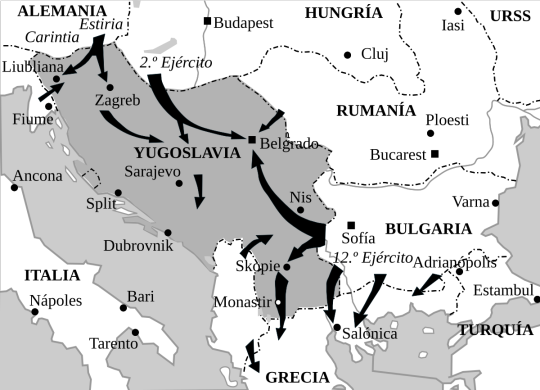
Apr.06.1941 - 第二次世界大戦・バルカン戦線 (第二次世界大戦): ナチス・ドイツがユーゴスラビアおよびギリシャに侵攻。(ユーゴスラビア侵攻・ギリシャの戦い)
0 notes
Text
‘Pimpernel of the Hellenes’, ‘Major Paddy’, ‘Enchanted maniac’: Will the real Paddy Leigh Fermor please stand up?
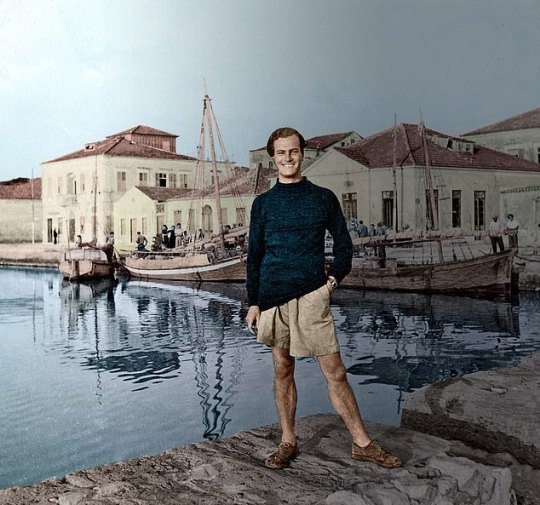
Paradox reconciles all contradictions.
- Patrick Leigh Fermor
So one evening I was baby sitting my nephews and nieces here in our family chalet in Verbier, high up in the Swiss Alps. It was my turn to baby sit as the rest of my family enjoyed the fantastic classical music concerts and events showcased at the two week long Verbier 30th Festival. The little scamps had gone to bed and my father and I watched an old British war movie on DVD, ‘Ill Met By Moonlight’ (1957). It was filmed by the legendary team of Michael Powell and Emeric Pressburger based on the 1950 book ‘Ill Met by Moonlight: The Abduction of General Kreipe’ by W. Stanley Moss.
I’ve seen the film a couple of times before, but until now never really paid attention to where the title came from. My father said it was from Shakespeare’s ‘A Midsummer’s Night’s Dream’ And so it was. In the play, Oberon, the king of the fairies and the Queen are having a fairly bitter drawn-out fight over custody of a changeling Indian child, and this is how the pissed off king greets the queen when they run into each other, “Ill met by moonlight, proud Titania”. Oberon is basically saying "Oh Lord, it's you..." and Titania's response is basically a flippant middle finger. One of the best modern reasons to read Shakespeare: to throw playful erudite shade at others.
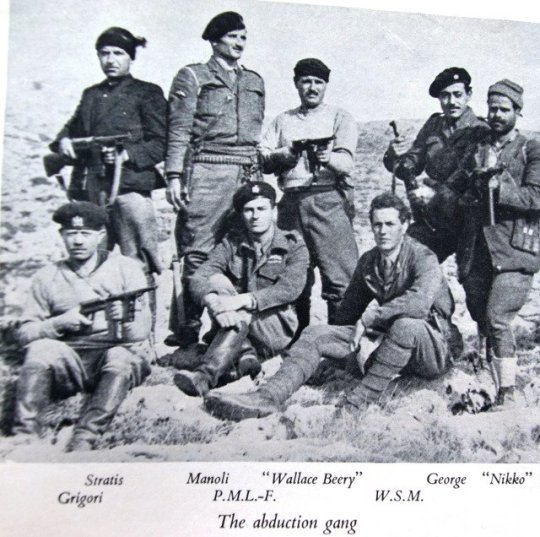
Anyway, the historical background of the film is the German invasion of Crete in May 1941. After an intense ten-day battle, Allied troops were driven back across the island, and many were evacuated from beaches along the southern coast. Some Cretans and British officers took to the mountains to organise resistance against the occupying forces. The German occupation that followed was especially brutal. Dreadful reprisals followed every act of resistance. The German commander, General Müller, insisted on taking 50 Cretan lives for every German soldier killed; he became known as ‘The Butcher of Crete’.
As a Classicist side note, there had been a close association between Britain and Crete since the early 20th century, when archaeologist Sir Arthur Evans had uncovered the sensational remains of a Minoan palace at Knossos. The headquarters of the British archaeological school in Crete was a large villa alongside the site, known as Villa Ariadne. Several archaeologists, who knew the island and its people well, went underground after the German occupation to aid the Cretan resistance. Continuing in this tradition, scholar and travel-writer Patrick Leigh Fermor, who had got to know Greece in the 1930s, joined the Special Operations Executive (SOE).
During the German occupation, Major Paddy Leigh Fermor travelled to Crete three times to help organise local resistance against the hated German occupation. On the third occasion, in February 1944, he was parachuted in with a specific mission to kidnap German commander General Müller, to boost morale on Crete along with his erstwhile SOE comrade Capt. W. Stanley Moss MC (aka Billy Moss) of the Coldstream Guards. However, just after they parachute in, General Müller was replaced by General Heinrich Kreipe, who transferred from the Russian Front. Thinking that capturing one general was as good as another, Fermor merrily go ahead with the daring kidnap operation.
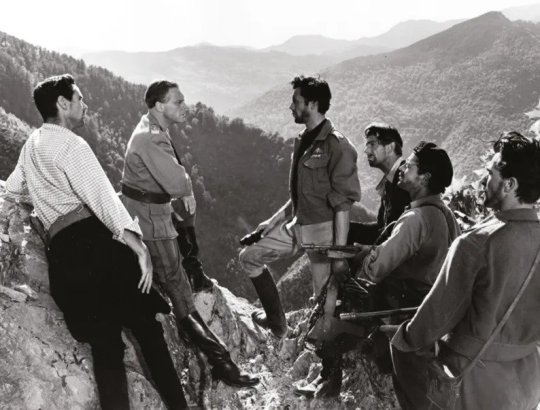
It’s at this point that the narrative of Michael Powell and Emeric Pressburger’s ‘Ill Met by Moonlight’ (1957) picks up. Dirk Bogarde plays Paddy Leigh Fermor, David Oxley plays Moss, and Marius Goring plays the taciturn German paratroop general. Blink and you’ll miss the late great Christopher Lee making a cameo appearance as a German officer in the dentist’s room scene.
The film naturally takes some liberty with the facts but it’s a cracking yarn of high adventure and drama. Xan Fielding, a close friend of Leigh Fermor from the SOE in Cairo, was taken on as technical adviser. The fact the film was shot in in the Alpes-Maritimes in France and Italy, and on the Côte d'Azur in France, far away from the craggy valleys and mountains of Crete itself. The director Michael Powell spent some time walking in Crete to get to know the island, but decided that, with the confused and volatile state of Greek politics, it was not suitable to film there.
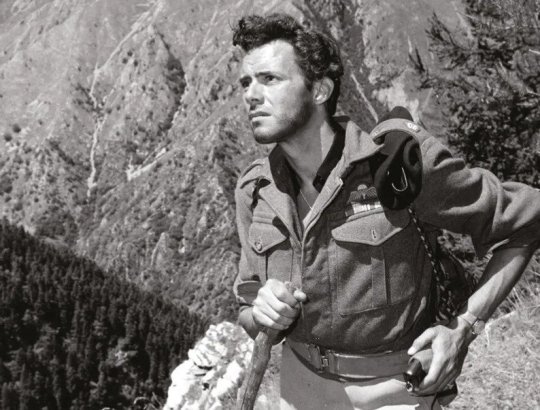
Looking back years after he had directed it Powell didn’t think much of his own film. By contrast, Paddy Leigh Fermor, who was on set throughout the film shoot, was very happy with Bogarde’s portrayal of him with Byronic glamour. Watching the movie again ‘Ill Met by Moonlight’ remains a classic and stands out from many British war films of the 1950s because of its realism. The British SOE men and the Cretan guerrillas look absolutely right for their parts. It is dramatic and full of suspense while filled with much boyish humour.
I was disappointed with one notable omission in the film that did happen in real life. According to Patrick Leigh Fermor, at dawn one day during the journey across the mountains, General Kreipe was looking at the mist rising from Mount Ida and began to recite, in Latin, the opening lines of Horace’s ninth ode:
Vides ut alta stet nive candidum
Soracte nec iam sustineant onus
silvae laborantes geluque
flumina constiterint acuto?
Behold yon Mountains hoary height,
Made higher with new Mounts of Snow;
Again behold the Winters weight
Oppress the lab’ring Woods below:
And Streams, with Icy fetters bound,
Benum’d and crampt to solid Ground
(John Dryden 1685)
Leigh Fermor picked up on the General, and recited the remaining stanzas of the Ode. ‘Ach so, Herr Major,’ said Kreipe when Leigh Fermor had finished. Both men were amazed to realise they shared a classical education and a love of ancient Latin poetry.
Leigh Fermor later wrote that it was as though the war had ceased to exist for a moment, as ‘We had both drunk from the same fountains before.’ It brought captor and captive together with a strange bond. The scene was not reproduced in the film, as Powell and Pressburger probably thought it would make the men sound too academic for a popular cinema audience.
Leigh Fermor and Kreipe met again in the early 1970s, on a Greek television show, and got on famously together. The General said Leigh Fermor had treated him chivalrously as a captive. They remained friends until Kreipe’s death.

After sharing a late night drink with my father after the film, I began to muse on the figure of Paddy Leigh Fermor, a family friend and someone I met along with his wife, Joan, as a little girl. My grandparents, and especially my grandmother, knew Paddy briefly from their days during and after the Second World War.
My father shared a few stories about him when he and my mother visited his beautiful home in Greece, where even at his advanced age he remained the most generous of hosts and the most outrageous flirt.
One of my memories was getting into his battered old Peugeot in the drive way and trying to drive it when my feet could barely touch the pedals. It wouldn’t have mattered in any case as the brakes didn’t work as he cheerfully said later as we careened around a dirt road to go around the mountains for a drive.
Many years later in April 2022, I tried to visit the home of the late Patrick and Joan Leigh Fermor - a sort of pristine shrine to their memory that one can also stay in any of the rooms as a vacation rental - in the coastal fishing village of Kadarmyli in the Peloponnese, as part of a hiking and mountaineering sojourn around Greece with ex-Army friends. We couldn’t stay there as it was already rented out to other guests, and so we stayed higher up the mountain in a villa, but we swam in front of the Fermor’s home which was on the water’s edge.
You could never put your finger on Paddy Leigh Fermor. He hid behind his gift for telling yarns, and pulling Ancient Greek verses out of the thin air, as well as boisterously singing local Greek songs with a drink in his hand.
Even after his death in 2011, the question keeps nagging as to who was Paddy Leigh Fermor?
The Dirk Bogarde film too seems to ask, who exactly is the ‘real’ Patrick Leigh Fermor - or the real anyone? Taking its title from a Shakespearian play concerned with dreams and disguises, magic and power, ‘Ill Met By Moonlight’ is all about questions of identity.
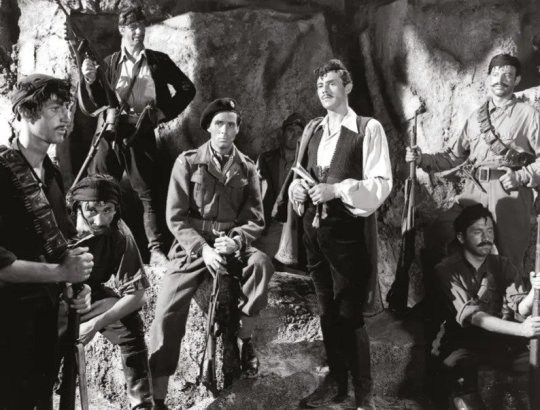
Under the film credits, we see Dirk Bogarde in uniform; then, unexpectedly, we see him in the flamboyant outfit of a Cretan hill-bandit. A title informs us that Major Leigh Fermor was also known by the Greek code-name “Philidem.” In other words, there are two of him (at least), and on one level the adventure the film is about to unfold reflects a conflict in his personality. It’s a conflict shared, unknowingly, by his Nazi opposite number, the fierce, arrogant General Kreipe (an unlikely “proud Titania,” but it’s true that he “with a monster is in love” – the monster of Nazism). Kreipe’s human side is so rigorously repressed by the demands of war and “glory” that he is genuinely unaware of it; ironically, this humanness, which constitutes the true manhood of this Teuton warrior, is revealed by a boy (equivalent to Shakespeare’s Indian Prince?) - who, in turn, is the most grown up person in the movie.
If “Philidem” appears under the credits, caped and open-shirted, a romantic dream-figure out of an operetta or a storybook, he is first seen in the film proper as a coarser, more down-to-earth version of the same thing – an ordinary Cretan peasant in a shabby suit, waiting for a bus. When he makes contact with the Resistance, his personality fragments further.
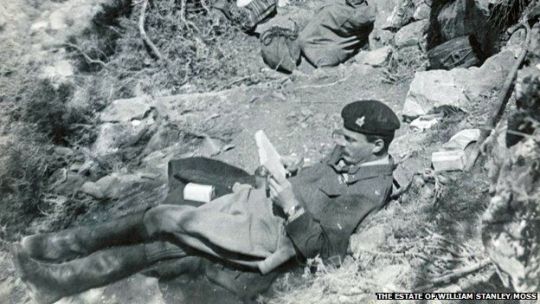
To some, he is the mystical Philidem, Pimpernel of the Hellenes and righter of wrongs. To others he is “Major Paddy,” the happy-go-lucky Englishman of popular movie myth conducting war as if it were a branch of amateur theatricals, a gentleman adventurer relying on breeding to get him through and making fun of the whole business. To Bill Moss (David Oxley), the newly arrived junior officer sent to assist him, he is the cool, fast-thinking professional soldier. And to himself? In his quietly passionate defence of Cretan life and culture, he seems someone else again: a scholar and aesthete outraged by the barbarism and folly of war, and by the moronic arrogance shown by his captive toward the Cretan people.
Whatever his persona, Leigh Fermor is a chameleon who never seems to change very radically in himself. Perhaps because he has this quality of seeming all things to all men – and being those things - he remains unfazed by the monolithic might of the German military machine. Fluent in Greek, he can also speak German like a German and is easily able to assume another disguise, that of a faceless Nazi officer. Although he and Moss make fun of themselves - “If only I had a monocle!” muses Moss when Leigh Fermor tells him he “looks like an Englishman dressed like a German, leaning against the Ritz bar” - they are able to effect the kidnapping with an ease that seems appropriately Puckish. General Kreipe is ignominiously thrust onto the floor of his own limousine, gagged, and sat upon by a couple of the peasants he so despises. Kreipe’s rage is compounded by his firm conviction that he has been snatched by “amateurs” - a belief Leigh Fermor and Moss slyly make no objection to, knowing how it will gnaw at his already shaky Master Race self-confidence.
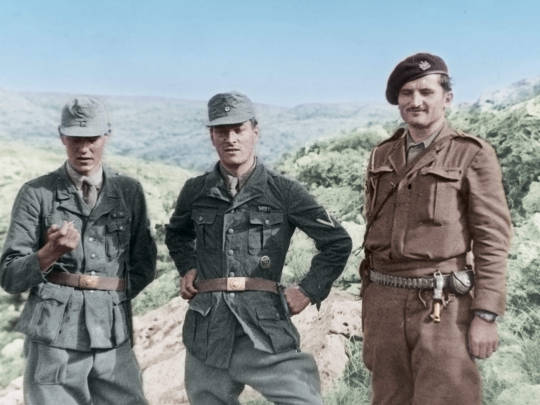
Patrick Leigh Fermor, aka Major Paddy, aka Philidem, in the film’s closing moments, is far from being self-assured intellectual or dashing amateur adventurer or legendary outlaw of the hills. He’s just a tired man who wants to go home and rest up. “How do you feel?” asks Moss. “Flat” is the reply. “You look flat!” says Moss. “I know how I’d like to look …” murmurs Leigh-Fermor wistfully. Moss knows what he’s going to say, and joins in the litany: “Like an Englishman dressed like an Englishman – and leaning against the Ritz bar!” It’s easy to imagine them ordering drinks at that renowned watering-hole with all the suavity required by this little fantasy.
Still, the film’s last images of Crete receding in the distance, until all we can see is the sea, suggests that maybe Major Paddy’s heart is really back in those hills in the “fair and fertile” land that has become as much a Powellian landscape of the mind for us as the studio-built Himalayan convent of ‘Black Narcissus’ or the monochrome Heaven of ‘A Matter of Life and Death’. And, as the film POV closing shots departs both Crete and this film, I began to think that being “dressed like an Englishman and leaning against the Ritz bar” would, for Patrick Leigh Fermor constitute yet another disguise. After all, he said he was of Irish aristocratic stock.
Traveller and writer Paddy Leigh Fermor is best known for two events. He’s known for leading the commando group in occupied Crete to kidnap General Kreipe. But he is also known for the boy who, at a mere 18 years old, set off with little money and a lot of nerve in 1933 to walk from the Hook of Holland to Constantinople.
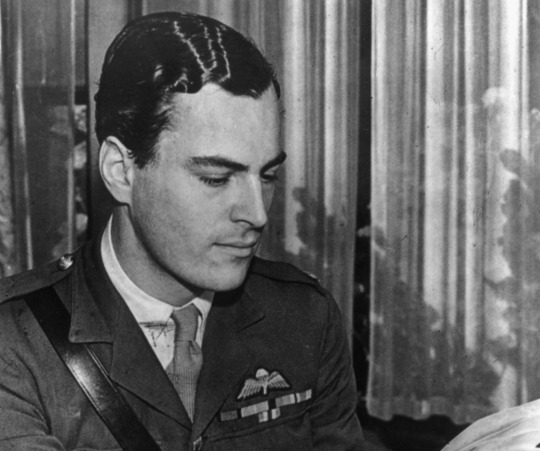
Patrick Leigh Fermor was, in the words of one of his obituaries, a cross between Indiana Jones, James Bond and Graham Greene. Self-reliance and derring-do were lessons learnt from the cradle. When Fermor’s geologist father was posted to India, he and his wife left the infant with family in Northamptonshire and did not return until his fourth birthday. In retrospect, he took great delight in being sent to a school for difficult children and getting himself expelled from the King’s School, Canterbury, when he was caught holding hands with a greengrocer’s daughter eight years his senior. His school report infamously judged him ‘a dangerous mix of sophistication and recklessness’.
Sharing a flat in Shepherd’s Market, one of Mayfair’s seedier corners, Leigh Fermor schooled himself in literature, history, Latin and Greek.
He honed his character with the company of extraordinary people and the words of great writers - he had a prodigious memory for prose as well as poetry. He befriended literary lions such as Sacheverell Sitwell, Evelyn Waugh and Nancy Mitford. His travels began aged ‘eighteen-and-three-quarters’ when he rejected Sandhurst Royal Military College in order to walk the length of Europe from Hook of Holland to Constantinople. He took with him Horace’s Odes and the Oxford Book of Verse though Leigh Fermor could recite Shakespeare soliloquies, Marlowe speeches, Keats’s Odes and as he modestly put it ‘the usual pieces of Tennyson, Browning and Coleridge’ from memory.
Leigh Fermor was then a self-made man in the most literal sense.

Setting off from England in 1933, Fermor resolved to traverse Europe living like a hermit; sleeping in bars and begging for food. But his manly charms and boyish good looks found him being passed like a favourite godson from Schloss to palace by European nobility and he developed a lifelong penchant for aristocratic company. I his own words, ‘In Hungary, I borrowed a horse, then plunged into Transylvania; from Romania on into Bulgaria’. Having reached Constantinople in January 1935, Fermor continued to explore Greece where he fought on the royalist side in Macedonia quelling a republican revolution. In Athens Leigh Fermor met Balasha Cantacuzene, a Romanian countess with whom he fell in love. They were living together in a Moldovan castle when World War Two was declared.
Fluent in Greek, Leigh Fermor was posted as a liaison officer in Albania. Recruited as a Special Operations Executive (SOE), he was shipped from Cairo to German-occupied Crete where he lived disguised as a shepherd in the mountains for two years. On his third expedition to Crete in 1944, Leigh Fermor was parachuted alone onto the island and made connections in the Cretan resistance movement. While waiting for his compatriot Captain Bill Stanley Moss to land by water from Cairo, Leigh Fermor hatched a plot to kidnap German Commander General Heinrich Krieple. He liaised comfortably with Cretan partisans and bandits to pull off one of the war’s greatest coups de théâtre.

Disguised as German soldiers, Leigh Fermor and Moss stopped Krieple’s car at an improvised check point en route back to Nazi HQ in Knossos. Abandoning the General’s car after a two-hour drive, Leigh Fermor left a note indicating that the kidnappers were British so that there wouldn’t be reprisals against Cretan nationals. When the abduction of the unpopular commander was discovered, a German officer in Heraklion allegedly said ‘well, gentlemen, I think this calls for champagne’. It turns out that General Kreipe was despised by his own soldiers because, amongst other things, he objected to the stopping of his own vehicle for checking in compliance with his commands concerning approved travel orders. It’s why for instance the German troops, both in the film and in real life, dare not stop the General’s car as it drove through the check points at Heraklion.
Krieple was evacuated and taken to Cairo and Leigh Fermor entered the annals of World War Two’s most devil-may-care heroes. With characteristic panache, when he was demobbed Leigh Fermor moved into an attic room at the Ritz paying half a guinea a night. But his first travel book, ‘The Traveller’s Tree’, was not about the European odyssey or the Cretan escapades and centred on Leigh Fermor’s adventures in the Carribbean. Published in 1950, ‘The Traveller’s Tree’ was an inspiration for Ian Fleming’s second James Bond novel ‘Live and Let Die’ (1954).
As a host and house guest, Paddy Leigh Fermor was much sought-after. At one of his parties in Cairo, he counted nine crowned heads. He was a confirmed two-gin-and-tonics before lunch man and smoked eighty to 100 cigarettes a day. His party pieces included singing ‘It’s a Long Way to Tipperary’ in Hindustani and reciting ‘The Walrus and the Carpenter’ backwards. In Cyprus while staying with Laurence Durrell, Leigh Fermor apparently stunned crowds in Bella Pais into silence by singing folk songs in perfect Cretan dialect. As Durrell wrote in ‘Bitter Lemons’ (1957), ‘it is as if they want to embrace Paddy wherever he goes’.
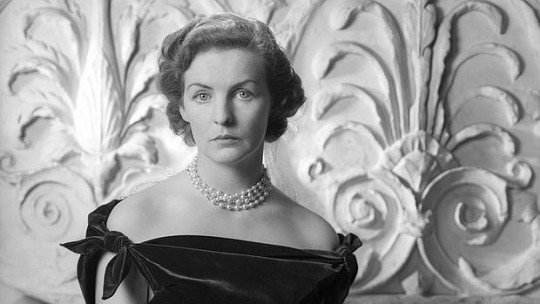
He struck up a partiuclar friendship with the famous Mitford sisters, especially Deborah Mitford, later ‘Debo’, the Duchess of Devonshire. It was at the Devonshires’ Irish estate Lismore Castle that ‘Darling Debo’ and ‘Darling Pad’ met and began to correspond. A characteristic letter from the Duchess in 1962 reads ‘The dear old President (JFK) phoned the other day. First question was ‘Who’ve you got with you, Paddy?” He’s got you on the brain’ to which Fermor replies of a broken wrist ‘Balinese dancing’s out, for a start; so, should I ever succeed to a throne, is holding an orb. The other drawbacks will surface with time’.
After the war he travelled widely but was always drawn back to Greece. He built a house on the Mani peninsula - which had been, significantly, the only part of Magna Graecia to resist Ottoman colonisation since the fall of Constantinople in 1453. Before his death in 2011 at the age of 96, he wrote some of the most acclaimed travel books of the 20th century.
His books contain some of the finest prose writing of the past century and disprove Wilde's maxim that "it is better to have a permanent income than to be fascinating".
Charm, self-taught knowledge and enthusiasm made up for the lack of a university degree or a private income. His teenage walk across Europe and subsequent romantic sojourn in Baleni, Romania, with Princess Balasha Cantacuzene are proof enough of that. But the difficulty of capturing such an unconventional and glamorous life is made harder by the certainty that Fermor was an unreliable narrator.

He was also an infuriatingly slow writer. Driven by a life-long passion for words yet hampered by anxiety about his abilities, Leigh Fermor published eight books over 41 years.
‘The Traveller's Tree’ describes his postwar journey through the Caribbean; ‘Mani‘ and ‘Roumeli’ (1958 and 1966) draw on his experiences in Greece, where he would live for much of the latter part of his life. But it is the books that came out of his trans-Europe walk that reveal both the brilliance and the flaws. ‘A Time of Gifts’ was published in 1977, 44 years after he set out on the journey. ‘Between the Woods and the Water’ appeared nine years later. Both describe a world of privilege and poverty, communism and the rising tide of Nazism, and end with the unequivocal words, "To be continued". Yet the third volume hung like an albatross around the author's neck. As the years passed, Fermor found it impossible to shape the last part of his story in the way he wanted.
Leigh Fermor was that rarest of men: a man determined to live on his own terms, if not his own means, and who mostly - and mostly magnificently - succeeded. Always popping off on a journey when he should have been writing about the last one, always ready to party, he was forever chasing beautiful, fascinating or powerful women, even when with his wife, Joan Raynor. She was the great facilitator who funded his passion for travel and writing, as well as women, from her trust fund. His love affairs were discreet but legendary.
Leigh Fermor was happiest among the rogues. Over a lifetime on the road, he sought them, and in turn they responded to his charm, nose for adventure, and his famous wit. He was a keenly-anticipated dinner guest - once outshining Richard Burton at a London society soirée, who he cut-off midway through a recital of ‘Hamlet’. As Richard Burton stormed out, the pleading society hostess said, “But Paddy’s a war hero!” to which Burton grouchily replied, “I don’t give a damn who he is!”
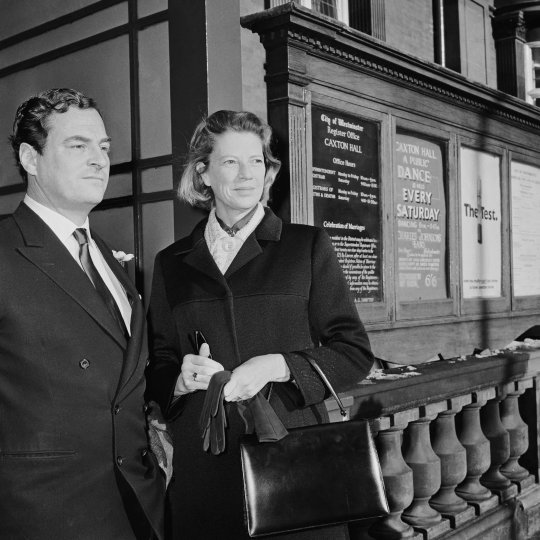
His partnership with and then marriage to Joan Raynor was an open relationship, at least on Leigh Fermor’s side. Paddy saw in Joan his kindred spirit. Like him, she spent much of her youth travelling to where she pleased; largely in France, where the photographer and literary critic Cyril Connolly became besotted by her. Joan was the daughter of Sir Bolton and Lady Eyres Monsell of Dumbleton Hall, Worcestershire. She was not only stunningly pretty but also 'a beautiful ideal, with the perfect bathing dress, the most lovely face, the most elaborate evening dress', as the Eton educated Connolly described her. Joan also stood out from the upper-class beauties of her day in that she supplemented her mean rich father's allowance by earning her living as a decent photographer.
In 1946, she met Leigh Fermor in Athens, while he was deputy director of the British Institute. Joan met him at a time when he was then in a relationship with a French woman called Denise, who was pregnant with his child, which she aborted. The pair would travel to the Caribbean together under the invitation of Greek photographer Costas, falling madly in love.

She was the only woman that - after decades of sexual scandals - matched his own erratic behaviour. Stories of how they dined fully-clothed in the Mediterranean, dragging a table into the sea, as well as their myriad cats and olive groves, paint a restless couple, who, when not out articulating the peoples of their adopted homeland, kept themselves very busy.
The attraction between Paddy and Joan was instant. So many love affairs that Paddy indulged in seemed about as brief as the flame from a burning envelope and you expected this one with Joan to be too. But somehow, miraculously, it lasts.
The two were apart a great deal, but in their case, absence did make the heart grow fonder. While Paddy was staying in a monastery in Normandy, supposed to be thinking monk-like thoughts that he would eventually put into his masterpiece A Time To Keep Silence, he was also writing sexy letters to Joan: 'At this distance you seem about as nearly perfect a human being as can be, my darling little wretch, so it's about time I was brought to my senses.' And: 'Don't run away with anyone or I'll come and cut your bloody throat.'
She tantalised him with descriptions of Cyril Connolly making passes at her; but she, like Denise, sounded a rather desperate note when she wrote: 'I got the curse so late this month I began to hope I was having a baby and that you would have to make it a legitimate little Fermor. All hopes ruined this morning.'
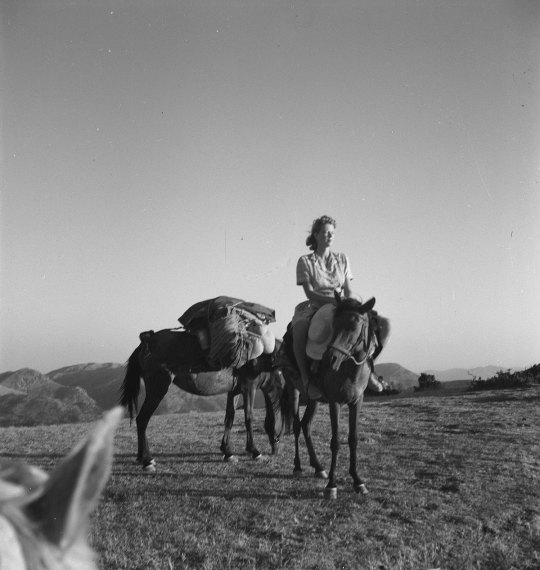
Fiercely independent - a trait that must have enamoured Paddy - they were best imagined as two pillars of a Greek temple, beside one-another but capable of holding up the roof of the world that they had built for themselves through the lens of ancient history and Hellenic culture. Indeed, it was said that they had a special ‘pact of liberty’. It is this unconquerable aura that led poet laureate John Betjeman to declare his love for her (he called her ‘Dotty’ and remarked that her eyes were as large as tennis balls). For Cyril Connolly, the photographer she shadowed, and with whom she had a scandalised affair during her first marriage, she was a “lovely boy-girl” and Laurence Durrell named her the ‘Corn Goddess’ because of her slender figure and short hair. But of all of these worthy candidates, it was the warrior-poet Patrick Leigh Fermor who finally won her heart.
To Joan, who described herself as a ‘lifelong loner’ in her diaries, her companionship with the uncomplicated Paddy was a relief. They had no children, nor did they want any - or so Paddy claimed. But those who knew Joan suspected she did want children but it never came to pass; and so she became a devoted aunt or dotted on other friends’ children. For both of them their dozens of cats gave them the next best thing to paternal satisfaction. Still, her morbid fascination with photographing cemeteries painted a much darker side.
Joan Raynor’s inheritance subsidised his peripatetic life at least until the enormous success of ‘A Time of Gifts’ in the late 1970s, which in turn created a new market for his previous volumes about Greece, ‘Mani’ and ‘Roumeli’.
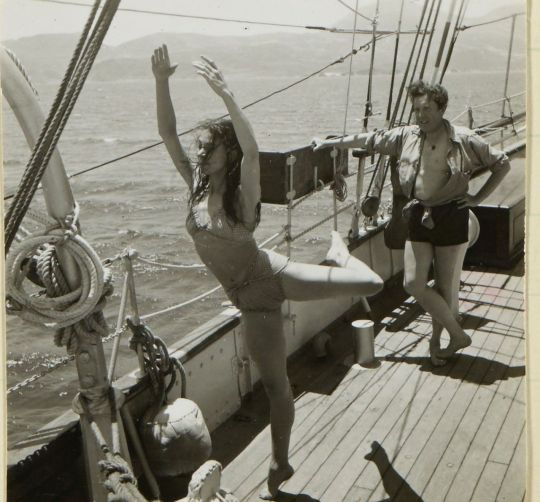
With Joan’s tacit consent, Paddy enjoyed amorous flings, discrete sexual affairs with high society women and sampled the low delights of the brothel. This activity rarely made it into his private letters, but the exceptions could be piquant. Writing in 1958 from Cameroon, where he was on the set of a John Huston movie, he told a (male) friend: “ Errol Flynn and I . . . sally forth into dark lanes of the town together on guilty excursions that remind me rather of old Greek days with you.” In a 1961 letter to the film director John Huston’s wife, Ricki, with whom Leigh Fermor had been having sex with (and would die in a car crash in 1969). “I say,” the passage begins, “what gloomy tidings about the CRABS! Could it be me?” Riffing on pubic lice and their crafty ways, he conjectures that, during a recent romp with an “old pal” in Paris, a force “must have landed” on him “and then lain up, seeing me merely as a stepping stone or a springboard to better things” - to Mrs. Huston, that is. As comic apologies for venereal infection go, the passage is surely a classic.
Like most high flying lives, it was far from blameless. Wounded women were littered in his wake. Some British visitors to Athens were less than impressed by this Englishman who posed as “more Greek than the Greeks”.
Some Greeks shared their disdain. Revisionist historians criticised his role in wartime Crete, and warned their fellow Hellenes that for all his fluency and charm, Leigh Fermor was no latter day Byron. His unoccupied car was blown up outside his Mani house, probably by members of the Greek Communist Party which he had vocally opposed. The accidental fatal shooting of a partisan in Crete led to a long blood feud which made it difficult for Leigh Fermor to re-enter the island until the 1970s, and possibly explains why he chose to settle in the Peloponnese rather than among the hills and harbours of his dreams.
His own books had already eclipsed those incidents, not only among readers of English but also in Greece, where in 2007 the government of his adopted land made him a Commander of the Order of the Phoenix for services to literature.
Travel writers such as the great Jan Morris have described Leigh Fermor as the master of their trade and its greatest exponent in the 20th century.

When ‘A Time of Gifts’ was published in 1977, Frederick Raphael wrote: “One feels he could not cross Oxford Street in less than two volumes; but then what volumes they would be!”
They are not for everyone. Leigh Fermor wrote that written English is a language whose Latinates need pegging down with simple Anglo-Saxonisms, and some feel that he personally could have made more and better use of the mallet. His exuberance is either captivating or florid. It is certainly unique among English prose styles.
Artemis Cooper, his patient and careful biographer wrote that “Paddy had found a way of writing that could deploy a lifetime’s reading and experience, while never losing sight of his ebullient, well-meaning and occasionally clumsy 18-year-old self … this was a wonderful way of disarming his readers, who would then be willing to follow him into the wildest fantasies and digressions”.
Those fantasies and digressions took decades to express. ‘A Time of Gifts’ had arguably been 40 years in the making when it was published in 1977. Its sequel, ‘Between the Woods and the Water’, did not appear until 1986. The third and final volume has been awaited ever since. Following Leigh Fermor’s death, a foot-high manuscript was apparently found on his desk.
Once he knuckled down to it, Leigh Fermor loved playing around with words. He was one of our greatest stylists and he was devoted to producing un-improvable books. But writing did not come easily to him, at least partly because it was something of a distraction from the main event, which was living an un-improvable life of unrepentant gaiety and fun.
For forty odd years, a legion of friends and admirers would beat a path to Paddy and Joan’s door. Artists, poets, royalty and writers came, all taking inspiration from their erudite hosts. A visit was an act of communion, a sharing of ideas and stories.
Leigh Fermor influenced a generation of British travel writers, including Bruce Chatwin, Colin Thubron, Philip Marsden, Nicholas Crane, Rory Stewart, and William Dalrymple. Indeed when Bruce Chatwin died, it was Paddy who scattered Chatwin’s ashes near a church in the mountains in Kardamyli.
When I was there in April 2022, I went to that same church to pay my respects.
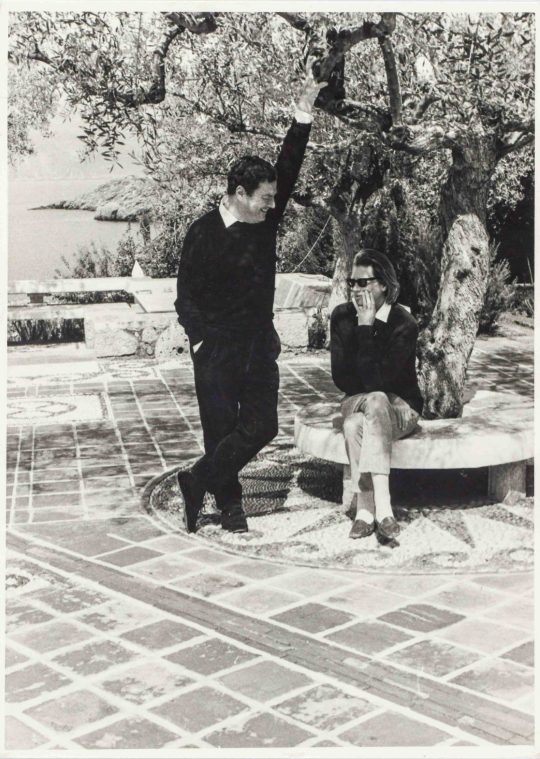
But some of Paddy’s life energy was sucked out of him when Joan died in Kardamyli in June 2003, aged 91. It was related that Joan said to her friend Olivia Stewart, who was visiting: 'I really would like to die but who'd look after Paddy?' Olivia said that she would. A few minutes later, Joan fell, hit her head - and died instantly of a brain haemorrhage. Joan had often quoted Rilke: 'The good marriage is one in which each appoints the other as guardian of his solitude.' Now Paddy Leigh Fermor was all alone.
Leigh Fermor was knighted in 2004, the day of his birthday which he delighted in like a giggling schoolboy. But he missed Joan terribly.
For the last few months of his life Leigh Fermor suffered from a cancerous tumour, and in early June 2011 he underwent a tracheotomy in Greece. As death was close, according to local Greek friends, he expressed a wish to visit England to bid goodbye to his friends, and then return to die in Kardamyli, though it is also stated that he actually wished to die in England and be buried next to his wife, Joan, in Dumbleton, Gloucestershire. He stayed on at Kardamyli until the 9th June 2011, when he left Greece for the last time. He died in England the following day, 10th June 2011, aged 96. It was reported that he had dined in full black tie on the evening of his death. Paddy had style even unto the end.

A Guard of Honour was formed by the Intelligence Corps and a bugler from his former regiment, the Irish Guards, delivered the ‘Last Post’ at Paddy’s funeral. As had been his wish, he was buried beside Joan. On his gravestone in Dumbleton cemetery is an inscription in Greek, a quote from Constantine Cavafy: “In addition, he was that best of all things, Hellenic.”
Although Joan had passed away at the age of ninety-one, after suffering a fall in the Mani. Her body was repatriated to Dumbleton, the place of her birth - ironic that her dream was to be as far as she could possibly go from the rolling humdrum Worcestershire hills. But perhaps she intended to return all along. When Paddy was buried beside her it seemed that the ‘pact of liberty’ that these two lonely souls had forged themselves could be tested in the great elsewhere. Joan was more than his muse (as many of her obituaries were at pains to declare) but his greatest adventure.
To come around full circle from the movie ‘Ill Met By Moonlight’ (1957) that I saw that night in Verbier, my father told me that rather poignantly, General Kreipe, the German commander Leigh Fermor had captured - once an enemy, and later a friend - left behind notes and photographs from across his life. On one of those notes, it was discovered, the following was scribbled from a brief visit to Greece: “Somewhere, amidst all the disarray, was the story of Joan and Paddy, and” it concluded, “…of their lives together.”
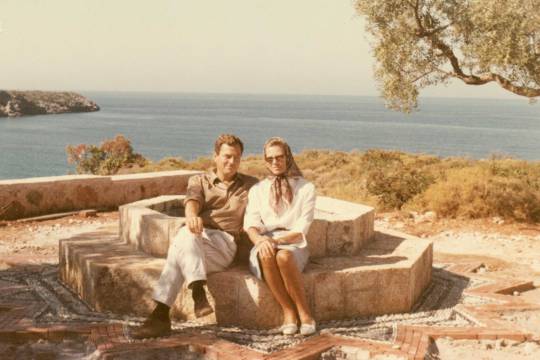
His life with Joan and all that she meant to him was one part of the mosaic of who Paddy Leigh Fermor was. But it’s incomplete.
Paddy didn’t like the idea of a biography, and neither did Joan when she was alive. But friends had persuaded them that unless Paddy appointed someone to write his life, he might find himself the subject of a book whether he liked it or not. In Artemis Cooper they couldn’t have chosen a better writer to chronicle Paddy’s life as a man of action and letters. Cooper, was the daughter of another accomplished diplomat and historian, John Julius Norwich, and grand-daughter of Duff and Diana Cooper. As the wife of the historian Antony Beevor, she became a trusted friend of the Leigh Fermors. Cooper was too good of a historian to let her friendship lead her astray from being a faithful but serious biographer. Knowing this, she was told she could go ahead, but she had to promise not to publish anything until after they were both dead.
Paddy did not like being interviewed, and would keep her questions at bay with a torrent of dazzling conversation. He was the master at deflecting discussions away from himself.
He was also very unwilling to let Cooper see many of his papers, though the refusal always couched in excuses. ‘Oh dear, the Diary…’ It was the only surviving one from his great walk across Europe, and I was aching to read it. ‘Well it’s in constant use, you see, as I plug away at Vol III,’ he would say. Or, ‘My mother’s letters? Ah yes, why not. But it’s too awful, I simply cannot remember where they’ve got to…’ It was quite obvious that he and Joan, while being unfailingly generous, welcoming and hospitable, were determined to reveal as little as possible of their private lives.
While they were more than happy to talk about books, travels, friends, Crete, Greece, the war, anything - they would not tell her any more than they would have told the average journalist. But she persisted and got closer than most. He showed particularly gallantry in not talking about his romantic entanglements. But she soon twigged that anytime he described a woman as ‘an old pal’ it was a sure bet that he had an affair with her.
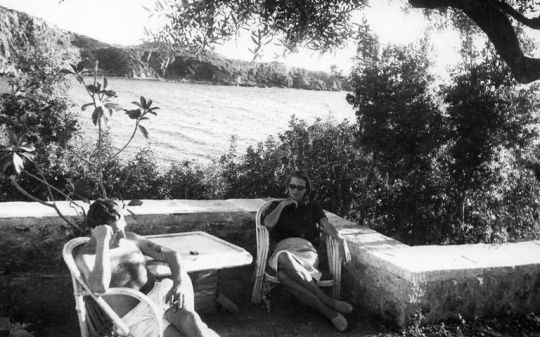
Intriguingly, Paddy liked to claim he was descended from Counts of the Holy Roman Empire, who came to Austria from Sligo. Paddy could recite ‘The Dead at Clomacnoise’ (in translation) and perhaps did so during a handful of flying visits to Ireland in the 1950s and 1960s, partying hard at Luggala House or Lismore Castle, or making friends with Patrick Kavanagh and Sean O’Faolain in Dublin pubs. He once provoked a massive brawl at the Kildare Hunt Ball, and was rescued from a true pounding by Ricki Huston, a beautiful Italian-American dancer, John Huston’s fourth wife and Paddy’s lover not long afterwards.
And yet, a note of caution about Paddy’s Irish roots is sounded by his biographer, Artemis Cooper, who also co-edited ‘The Broken Road’, the final, posthumously published instalment of the trilogy. “I’m not a great believer in his Irish roots,” she said of Leigh Fermor in an interview, “His mother, who was a compulsive fantasist, liked to think that her family was related to the Viscount Taaffes, of Ballymote. Her father was apparently born in County Cork. But she was never what you might call a reliable witness. She was an extraordinary person, though. Imaginative, impulsive, impossible - just the way the Irish are supposed to be, come to think of it. She was also one of those sad women, who grew up at the turn of the last century, who never found an outlet for their talents and energies, nor the right man, come to that. All she had was Paddy, and she didn’t get much of him.”
And I think that’s the point, no one really got much of Paddy Leigh Fermor even as he only gave a crumb of himself to others but still most felt grateful that it was enough to fill one’s belly and still feel overfed by him.
Paddy never tried to get to the bottom of his Irish ancestry, afraid, no doubt, of disturbing the bloom that had grown on history and his past, a recurring trait. “His memory was extraordinary,” Artemis Cooper noted, “but it lay dangerously close to his imagination and it was a very porous border.”
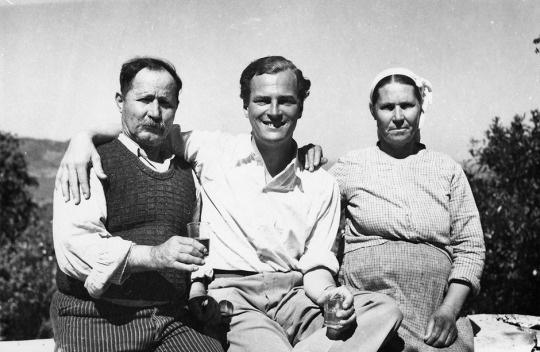
Within the Greek imagination many Greeks saw in Paddy Leigh Fermor as the second coming of Lord Byron. It’s not a bad comparison.
Lord Byron claimed that swimming the Hellespont was his greatest achievement. 174 years or so later, another English writer, Patrick Leigh Fermor - also, like Byron, revered by many Greeks for his part in a war of liberation - repeated the feat. Leigh Fermor, however, was 69 when he did it and continued to do it into his 80s. Byron was a mere 22 years old lad. The Hellespont swim, with its mix of literature, adventure, travel, bravery, eccentricity and romance, is an apt metaphor for Leigh Fermor’s life. Paddy Leigh Fermor was the Byron of his time. Both men had an idealised vision of Greece, were scholars and men of action, could endure harsh conditions, fought for Greek freedom, were recklessly courageous, liked to dress up and displayed a panache that impressed their Greek comrades. Like a good magician it was also a way to misdirect and conceal one’s true self.
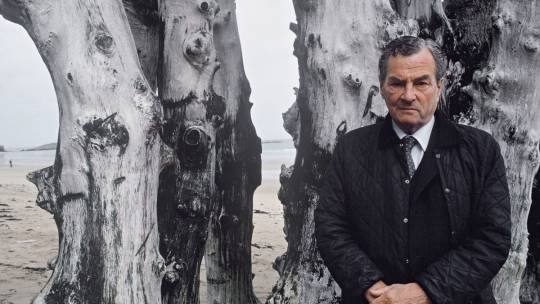
What or who was the true Paddy Leigh Fermor?
Like Byron, Leigh Fermor appeared as a charismatic and assured figure. He was a sightseer, consuming travel, culture, and history for pleasure. He was an aristocrat moving in the social circles of his time. He was a gifted amateur scholar, speculating on literary and historical sources. Leigh Fermor, Byron’s own identity, is subject to textual distortion; it emerges from a piece of occasional prose in his books and is shaped by the claims of correspondence on a peculiarly fluid consciousness.
There is no hard and fast distinction to be drawn here between real and imagined, only a continuity of relative fictions that lie between memory and imagination as his biographer asserted. If there is a will to assert identity here, to disentangle fact and fiction, to give things as they really are and nail down the real Leigh Fermor then it is somewhere between the two. This is where we will find Paddy.
For many his death marked the passing of an extraordinary man: soldier, writer, adventurer, a charmer, a gallant romantic. As a writer he discovered a knack for drawing people out and for stringing history, language, and observation into narrative, and his timing was perfect. Paddy often indulged in florid displays of classical erudition. His learned digressions and serpentine style, his mannered mandarin gestures, even baroque prose, which Lawrence Durrell called truffled and dense with plumage, were influenced by the work of Charles Doughty and T.E. Lawrence. But one can’t compare him. I agree with the acclaimed writer Colin Thurbon who said, “There is, in the end, nobody like him. A famous raconteur and polymath. Generous, life-loving and good-hearted to a fault. Enormously good company, but touched by well-camouflaged insecurities. I would rank him very highly. ‘The finest travel writer of his generation’ is a fair assessment.”
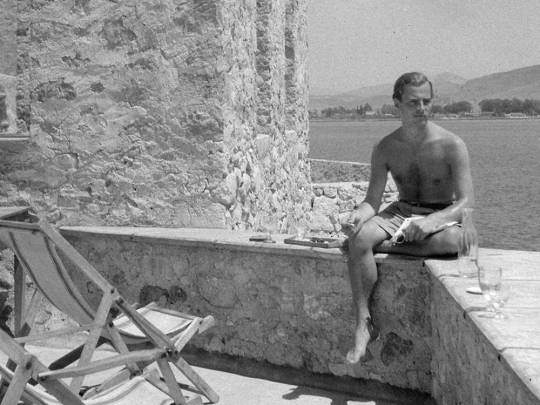
As a child I didn’t really know who Paddy Leigh Fermor was other than this very cheerful and charismatic old man was kind, attentive, and took a boyish delight in everything you were doing. Only later on in adulthood was it clear to that Paddy was not only among the outstanding writers of his time but one of its most remarkable characters, a perfect hybrid of the man of action and the man of letters. Equally comfortable with princes and peasants, in caves or châteaux, he had amassed an enviable rich experience of places and people. “Quite the most enchanting maniac I’ve ever met,” pronounced Lawrence Durrell, and nearly everyone who’d crossed paths with him had, it seemed, come away similarly dazzled.
I am equally dazzled - more smitten in retrospect - for alas they don’t make men like Paddy any more. But every time I dip back into his books I think I discover a little bit more of who Paddy Leigh Fermor was because I find him some where between my memory and my imagination.
#essay#paddy leigh fermor#leigh fermor#joan raynor#joan leigh fermor#greece#crete#second world war#SOE#war#british army#history#general kreipe#stanley moss#literature#author#writer#travel#explorer#wanderlust#travel writing#europe#mani#peloponnese#kardamlyi#lord byron#ill met by moonmight#film#movie#personal
113 notes
·
View notes
Photo

Bulgaria during World War 2.
Bulgaria initially pursued a policy of neutrality but later joined the Axis powers in 1941. The decision to align with the Axis was driven by territorial and political aspirations rather than ideological reasons. Bulgaria's involvement in the war primarily focused on territorial gains, such as regaining lost territories from previous conflicts.
Bulgaria participated in the invasion of Yugoslavia and Greece alongside the Axis powers in 1941. However, it did not actively engage in military operations against the Soviet Union. The Bulgarian government, led by King Boris III, resisted pressure to deport its Jewish population, and as a result, most Bulgarian Jews survived the war. In 1943, facing the changing tide of the war, Bulgaria switched sides and joined the Allies. This shift came after the Soviet Union declared war on Bulgaria. Despite this change, the country was occupied by German forces until 1944. After King Boris III's death in 1943, Bulgaria eventually became part of the Allied powers, and the Soviet Union played a significant role in liberating the country in 1944.
by danmaps_org
67 notes
·
View notes
Text
Flag of the Kingdom of Mongolia
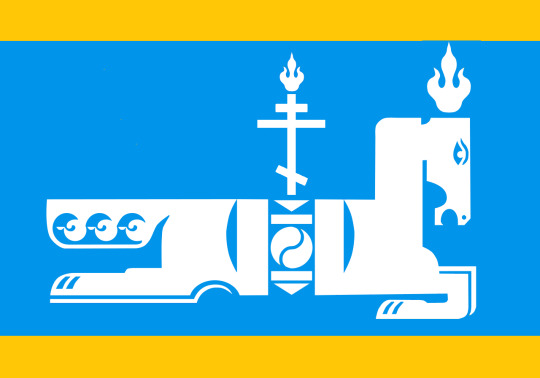
This is the flag of the Kingdom of Mongolia. It comes from a world where China successfully repelled the Mongols early on. As a result, the Mongol Empire never came to be. The Mongols continued to be pushed farther and farther west until they arrived in Eastern Europe. Eventually, they settled around where Romania and southern Poland are in our world. Thus, the Kingdom of Mongolia was born. The Mongols were frequently visited by Byzantine missionaries, and the Mongolian Orthodox Church is the official state religion. The Byzantine Empire also remains a major trading partner for Mongolia. In more peculiar alliances, Mongolia is also a major ally of the tiny mountainous nation of Neo Hellas, the final remnant of pagan Greece.
The coming of the Mongols altered the migration patterns of several other peoples. For example, the Bulgars settled in Russia, establishing the Czardom of Bulgaria. Meanwhile, several Germanic tribes invaded Greece, and Byzantium is currently ruled by a Germanic dynasty. Islam was still founded, but it never expanded beyond the Arabian Peninsula.
In terms of bad relations, Mongolia has always had a very tense relationship with the Franco-Saxon Kingdom. Throughout the years the Franco-Saxons have repeatedly attempted to conquer the Mongolians. Even after all these years, Mongolia remains bitter about the Franco-Saxon invasion that occurred during the Second Great Patriotic War. Despite this, in more recent times there has been increasing emphasis on moving on and letting go of the past. Younger generations in particular are more likely to support reconciliation between the two nations.
Mongolia takes pride in its dual mature of East Asian heritage and Eastern European culture. The flag reflects this dual heritage. The blue recalls both the cloak of the Virgin Mary and the eternal blue sky of the Tengrism. The horse symbolizes the nomadic past of the Mongolian people, before they settled in Eastern Europe. The cross represents the Mongolian Orthodox Church, with the flame representing the flames of Pentecost. The interlocking circles halves represent the dual nature of the Mongolian people. The golden bands represent the hope that the Mongolian people will always prosper no matter what life throws at them. They also help to offset the blue on the main body of the flag.
https://drakoniandgriffalco.blogspot.com/2019/03/flag-of-kingdom-of-mongolia.html?m=0
#alternate history#alternate history flag#alternate history flags#vexillology#flag#flags#mongolia#Kingdom of Mongolia#Flag of the Kingdom of Mongolia#Romania#Poland#ukraine#moldova#eastern europe#Mongols#alt history
38 notes
·
View notes
Text
youtube
This is the story of how a small nation played a decisive role in the Axis Powers' defeat.
The Greek victory against the Italians was the first official victory against the Axis,. It shattered the myth of the invincibility of the Axis, as mentioned in the video.
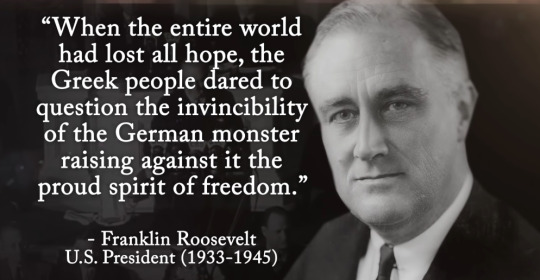
When Greece said No, the entire European continent was under the Axis control and London was getting bombed by the Luftwaffe. The USA were not yet in the war, and the USSR had agreed with the Nazis to invade Poland. Greece was fighting alone.
Greece was exhausted from continuous wars since 1897, and yet it was the only country in WW2 that fought at the same time with four enemies (Germany, Italy, Bulgaria, and Albania).
This small nation had only two tanks and practically no airforce.

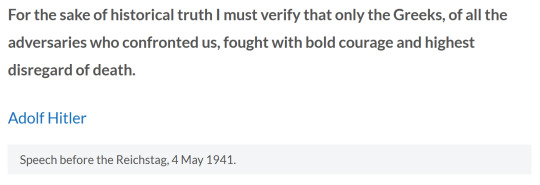
Mussolini thought conquering Greece was a matter of days.
However, the Greek army delayed the German invasion of the USSR for about 2 months. By then, winter in the USSR had settled for good, which played a major role in the defeat of the Germans.


Everyone fought because they knew the country was doomed if the Axis forces won. Women climbed the mountains (Pindos) on foot into the snow to bring food, blankets and ammunition, and, afterwards, brought the wounded soldiers back down. The resilience of Greek women was commemorated in songs, as well as the bravery of fighters on the Pindos mountains.

Let us also salute the brave British, New Zealander, and Australian people who fought with the Greek troops and died for Greece in both the mainland and Crete. It's scary to thing what Europe would be today had the Axis Powers won. You're all heroes.
53 notes
·
View notes
Text
Atlantis's connections to Antisemitism
CW: ww2 n4z1s, antisemitism.
I'm at the point where i'm writing up my grimore section on the dangers of conspiracy theories, I just finished my page on starseeds and now i'm on to Atlantis. I originally wrote this as just a point in a previous post but I wanted to share my findings here with y'all.
Atlantis's Origins
So in my previous post i labelled the topic as Atlantis origins in antisemitism, that was incorrect. Atlantis was first told as a story by philosopher Plato in 360 B.C as an analogy for hubris and served as a comparison to Athens. in the story, the city was founded by demigods and formed a utopia taking advantage of the abundant resources on the Atlantean islands and became a great naval power. The city eventually grew too powerful and it's people too arrogant; it fell out of favour with the gods and was then destroyed and sunk into the Atlantic Ocean.
A Dangerous Snowball
The popularisation of the Atlantis story in our current times came from the n4z1 group the Ahnenerbe during ww2 (who also popularised many other modern conspiracy theories like ancient aliens and the ice wall) but that's not where the snowball started.
In the 18th century, french astronomer Jean-Slyvain Bailey centralized the Atlantis myth to the, also, mythical continent of Hyperborea a reoccurring location in ancient Greek stories.
Helena Blavatski a Russian-German Aristocrat, theosopher and Neo-Platonist was inspired by this idea and reshaped it to fit into her book The Secret Doctrine (a pseudo-scientific book that was popular among occultist and esoterics, that also included N4z1s. This book provided the n4z1 party with mythical precedent for their ideology and became the foundation of the Ahnenerbe, founded by Heinrich Himler, the man directly responsible for orchestrating the death of 11 million people.
Also overseen by Richard Walter Dava the man who coined the whyte nationalist phrase "blut und bogen" (blood and soil) and Herman Wirth, author of another pseudoscience book: The Rise of Mankind: An investigation into the religion, symbolism and writing of the Atlantic nordic race. This book was about the pre-history of the fictional Atlantis but this time populated by a race of hyperborean nordic superhumans.
The Devastating Effects
This book formulated the idea between the Ahnenerbe group that when Atlantis was mysteriously destroyed the survivors went on to populate the continent of Europe and the Mediterranean. Those people then went on to develop the cities and architecture of Greece and Rome and Egypt etc.
The job of the Ahnenerbe then was to go around the world looking for evidence of this ancient "Aryan Master race" (aka begging the question) in order to justify the invasion of those countries.
Thousands upon thousands of people lost their lives during this time and hundreds of cultures lost parts of their history to the Ahnenerbe some of which were completely destroyed in raids.
------------------------------------------------------------------------------
I think this information is important because Atlantis is such a popular tool in media we need to know what affect it had on our history.
Nobody is immune to antisemitism.
#noone is immune to antisemitism#this is important#atlantis#the story of atlantis#witchblr#witch#witchcraft#pagan#pagan witch#paganism#hellenic pagan#hellenic witch#grimoire#grimoire pages#writing#witch tips#history#eclectic pagan#paganblr
91 notes
·
View notes
Text

St. David’s Day Special: The Dragon Prophecy
~ ~
Welcome to Celtic Month! For the entire month of March, the Spring Vignettes series will be dedicated entirely to Celtic homage vignettes. Non-Celtic pieces will resume in April.
Quick clarification: It’s pronounced Keltic, unless it’s a sports team; and even then, any linguists in the room will cringe if you pronounce it Seltic.
Our first Celtic Month piece celebrates St. David’s Day, on March 1st, the national day of Wales. Have some cheese toast! Pet a dragon! Kiss a Welshman, if you can find one.
Before you read what the piece means to me, share what it means to _you_. I’m just the artist; you’re the beholder.
Leave a comment.
~ ~
The Welsh are the survivors of the Celtic Britons, who were the inhabitants of all southern Britain before the Angles, Saxons, and Jutes invaded and established what became England. “Welsh” is an Anglo-Saxon term; it means “other people” or “foreigners”, which is ironic, considering the Germanic-speaking peoples were the foreigners in the native lands of the Britons.
There is certainly no more famous Welshman than King Arthur Pendragon, a legendary king of yore who supposedly ruled Britain between the retreat of the Romans and the invasion of the Saxons. His legend, much-developed over the centuries, became well-known throughout Europe in later times.
A notable legend tells of the building of Dinas Emrys, a castle on a hill by the Glaslyn river. By some accounts, it was built by Uther Pendragon, father of King Arthur; by other accounts, it was Vortigern, the same foolish king of the Britons who later invited the Saxons into Britain as mercenaries to defend the Britons from the Picts.
After the king had chosen the hill on which the castle would stand, his builders went to work; but every day, they built up the walls, only for them to topple overnight. No progress could be made. At length, the king asked his wisemen to find the cause and the solution to the problem.
His wisemen told him that for the building to succeed, a sacrifice would be necessary; and the sacrifice must be a boy not sired by mortal man. Such a boy existed; a young boy named Merlin, or Ambrosius, the baptized son of a devil, who would go on to be known for his abilities in the magic arts.
(Foundation sacrifices were once an incredibly widespread custom; we know from archaeological evidence that the burying of a human victim under the foundation of an important building was practiced in ancient Ireland. Similar legends are told in Romania, Greece, Japan, and elsewhere. Animals were later buried under foundations after human sacrifices ceased.)
The boy was brought to the hill; and the king’s wisemen told the king to sacrifice him to appease the heathen gods so that the castle could be build. But the boy laughed at their advice, and told the king he knew much better. He told the king that if a hole were dug, there would be found a deep, dark pool; and in that pool, there would be found two dragons, one red, one white; and it was the fighting of these dragons that shook the hill each night and made the walls collapse.
The king had a deep hole dug; and indeed, there was found a deep, dark pool; and from that pool indeed emerged two dragons, one red, one white.
Freed from their imprisonment, the dragons fought viciously, until, despite being the lesser of the dragons, the red dragon defeated the white dragon, and drove it out of the land across the sea.
The boy then prophesied that, just as the red dragon triumphed over the white dragon, so the Britons would triumph over the invading Saxons.
And they did; until the death of King Arthur at the hands of his son Mordred, whereafter, the Saxons finally defeated the Britons, and drove them into the western mountains.
The great Welsh sagas, the Mabinogion, tell about how the two dragons originally became trapped under the site of Dinas Emrys, when an ancient Welsh king intoxicated them with a cauldron of ale and buried them to silence their deafening shrieking.
#st_davids_day#wales#welsh#dragons#uther#vortigern#merlin#dinas_emrys#arthurian#celts#celtic#spring#springholidays#digitalart#vector#mosaic#collage#inkscape
48 notes
·
View notes
Text

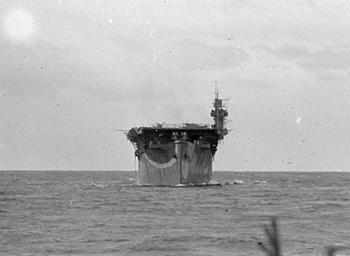

On March 27th 1943 tragedy struck when Aircraft carrier HMS Dasher blew up and sank off the island of Arran.
80 years ago today HMS Dasher, a hastily converted aircraft carrier, mysteriously exploded and sank within eight minutes in the Clyde. Of the 528 men on board, only 149 survived. 379 lives were lost. Of the 379 who perished, only 23 were given an official burial. However many more bodies – either brought ashore or washed up on local beaches and possibly burned beyond recognition, lie in unmarked plots. To this day, no acknowledgement has been made of the number or the whereabouts of these unmarked graves. The lasting and callous secrecy has left hundreds of families not knowing what happened to their sons, brothers, relatives or loved ones and most went to their graves still not knowing.
An official Board of Enquiry was hastily convened and within just two days they concluded that the Dasher had sunk due to an internal petrol explosion. However, several key witnesses were not called to give evidence. The official cause of her sinking is still doubtful. It could have been a mine or even possibly sabotage but it could also have been one of the first cases of friendly fire. The findings of the Board of Enquiry were never released until 1972 and even now information is being witheld. This is just part of a veil of secrecy which has surrounded HMS Dasher ever since. Rescuers, survivors and witnesses – everyone with any knowledge of what befell the Dasher in these waters – all were sworn to secrecy.
There is a strong possibility that one of the bodies from the Dasher was used in Operation Mincemeat to dupe the Germans about a possible invasion of Greece at a crucial time of the war in 1943. The loss of HMS Dasher and 379 young lives is still not fully understood by those affected. Mystery still surrounds the sinking, the burial graves and the true identity of the Operation Mincemeat body. Perhaps when all the facts have been revealed, they can be finally laid to rest.
Memorial events took place in Ardrossan over the past weekend to remember those that were lost.
27 notes
·
View notes
Text

Junkers Ju 87 Stuka gunner's view of the target as his aircraft pulls away over Greece in 1941
13 notes
·
View notes
Photo

By the standards of the hapless Greek monarchy, Constantine II, the last king of the Hellenes, who has died aged 82, led a comfortable life in exile after a brief and turbulent reign. Of the seven Greek monarchs of the 19th and 20th centuries, three were deposed, one assassinated, two abdicated and one died of septicaemia after being bitten by a barbary ape in the royal gardens.
The Glücksburg monarchy was German-Danish in origin, imposed on Greece in the 1830s. During prolonged wrangling after Constantine’s deposition, the Greek government refused to give him a passport until he acknowledged that he was Mr Glücksburg, whereas he insisted he was just plain Constantine. As the last of Greece’s deposed monarchs he escaped lightly. But decades of exile in London, as one thing the Greeks did not want back from Britain, were not how he would have chosen to spend his life.
In Hampstead Garden Suburb, Constantine lived in some state – apparently supported largely by donations from Greek monarchists – and visitors were expected to address him as Your Majesty. He was included in many invitations by the British royal family, to whom, like most of Europe’s monarchies, he was related. Prince Philip was his father’s first cousin, King Charles III his second cousin and Queen Elizabeth II a third cousin, and he was a godfather to Prince William. His wife was a Danish princess, the sister of Denmark’s Queen Margrethe II, and his sister Sofía became queen of Spain. Only in Greece was he unrecognised, and he was not allowed to return to live there until 2013, long after the events that had toppled him from the throne after a military coup in 1967 and resulted in the abolition of the monarchy in Greece in 1973.
In many ways, Constantine was a victim of the vicious political infighting that has characterised Greek politics and its society for much of the period since the second world war. It perhaps needed a stronger, more experienced and more resolute approach to surmount the crises of his three-year reign than the young man in his early 20s could manage. In later life he said in an interview that he might have liked to be an actor or a journalist, but his fate was to spend his life as an ex-king, harried by Greek politicians and in turn harassing them in a prolonged legal fight for compensation for his family’s lost property, eventually through the European court of human rights.
Born in Athens, Constantine was the son of the Greek crown prince, Paul, the younger brother of King George II, and his German-born wife Princess Frederica, and was taken into exile as a baby following the Italian and then Nazi invasions of the country in 1940-41. His early years were spent first in Egypt and then in South Africa, before the family returned to Greece following the referendum that restored George to the throne in 1946. George died the following year, and Paul became king.
Constantine was educated at a private high school in Athens, modelled on the same lines as the German educationist Kurt Hahn’s principles at Gordonstoun, and afterwards attended Athens University to study law. A keen sailor, Constantine was a member of Greece’s winning sailing team at the 1960 Rome Olympics – the country’s first gold medal in nearly 50 years.
He succeeded to the throne aged 23 on his father’s death in March 1964, becoming head of state in a country that had not got over the civil war between communists and the Greek government of 1946-49, and where political tensions and divisions continued to run deep. The CIA, desperate to avoid Greece falling into communist hands, was also active in Athens. Greece was a strategic pawn between the US and the Soviet Union, each anxious to pull the country into its sphere of influence in the eastern Mediterranean. At the same time, it was attempting to modernise with social and economic reforms as an associate member and applicant to join the Common Market.
The month before Constantine came to the throne, a general election had produced a centrist – moderate, leftwing – government under George Papandreou, following 11 years of rightwing government. Within a year, relations between the king and his prime minister were breaking down. Conservative army officers were alarmed by a perceived leftwards drift among the junior ranks, who were supported by Papandreou’s Harvard-educated son Andreas. When George Papandreou announced that he would take over the defence ministry himself, Constantine refused to allow him to do so, and the government resigned. In the hiatus that followed, the king attempted to appoint a government without holding an election and was accused of acting unconstitutionally.
When elections were finally called in April 1967, the likely re-election of Papandreou was forestalled by an army coup led by colonels. Constantine initially appeared to go along with the insurgents. He argued later that he had had no choice as the palace was surrounded by army tanks, but there were also persistent suggestions that he had been urged by the American embassy to do so in order to avoid another radical government. Many Greeks and civilian politicians never forgave the king for acceding to the coup, but within months he attempted a counter-coup of his own, fleeing to loyalist troops in the northern city of Kavala that December in an attempt to create a rival military support and force the junta to resign.
The operation was poorly organised and, although the air force and navy declared their support, the army and its officers rallied to the coup leaders. Support for the king melted away within 24 hours. Fearing bloodshed if it came to a military confrontation, Constantine and his family fled into exile, first in Rome and then a few years later in London.
There was no going back for the king. The junta, led by Colonel Georgios Papadopoulos, brutally consolidated their regime using censorship, mass arrests of opponents, torture and imprisonments, and were not going to reinstate Constantine after his attempted coup. When monarchist navy officers unsuccessfully attempted to overthrow the colonels in June 1973, Papadopoulos declared the country a republic, endorsed subsequently in a plebiscite widely assumed to have been rigged.
Nonetheless, when the regime fell following the Turkish invasion of Cyprus in 1974, to be succeeded by a civilian government, a further referendum was held to determine whether the king should be restored. Constantine was not allowed to return in order to campaign on his own behalf, though he was allowed to broadcast an address from London in which he apologised for his previous errors. But his maladroit interference with the civilian governments before the coup was held against him and the outcome of the vote in December 1974 was heavily in favour of a republic: by 69% to 31%.
Thereafter, for decades, Constantine was prevented from visiting Greece except briefly and on rare occasions: for his mother’s funeral in 1981 and for an attempted holiday in 1993, when he found his yacht was constantly harried by torpedo boats and aeroplanes. The following year, the Greek government revoked his citizenship and passport and seized the royal family’s property. “The law basically said that I had to go out and acquire a name. The problem is that my family originates from Denmark and the Danish royal family haven’t got a surname,” he said, adding that Glücksburg was the name of a place not a family: “I might as well call myself Mr Kensington.”
In 2000, the court of human rights found for the king in relation to the property, though it could only order compensation, not the return of his extensive estates nor the royal palace at Tatoi and awarded him only 12m euros (around £10m), rather than the 500m he had asked for: a reduction that the Greek government counted as a triumphant vindication. It nevertheless took another two years to pay the money and, when it did so, the government took it from its extraordinary natural disasters fund rather than general reserves. In retaliation, Constantine used the money to set up a charitable foundation in the name of his wife to assist Greeks suffering from natural disasters. He said: “I feel the Greek government have acted unjustly and vindictively. They treat me sometimes as if I am their enemy – I am not the enemy. I consider it the greatest insult in the world for a Greek to be told he is not a Greek.”
Generally, while expressing a wish to be allowed to live in Greece, which was granted in 2013, Constantine seemed equable about his fate and did not attempt to regain the throne. “All I want is to have my home back and to be able to travel in and out of Greece like every other Greek. I don’t have to be in Greece as head of state. I am quite happy to be there as a private citizen,” he told the Sunday Telegraph in 2000. “Forget the past, we are a republic now. Let’s get on with the future.”
Constantine is survived by his wife, Princess Anne-Marie of Denmark, whom he married in 1964; and their three sons, Pavlos, Philippos and Nikolaos, and two daughters, Alexia and Theodora.
🔔 Constantine II, former King of Greece, born 2 June 1940; died 10 January 2023
Daily inspiration. Discover more photos at http://justforbooks.tumblr.com
44 notes
·
View notes
Note
Hi Dr Reames!
Would you say that Macedon shared the same "political culture" with its Thracian and Illyrian neighbours, like how most Greeks shared the polis structure and the concept of citizenship?
I don't really know anything about Macedonian history before Philip II's time, but you've often brought up how the Macedonians shared some elements of elite culture (e.g. mound burials) with their Thracian neighbours, as well religious beliefs and practices.
I've only ever heard these people generically described as "a collection of tribes (that confederated into a kingdom)", which also seems to be the common description for nearby "Greek" polities like Thessaly and Epiros. So did these societies have a lot in common, structurally speaking, with Macedon? Or were they just completely different types of polities altogether?
First, in the interest of some good bibliography on the Thracians:
Z. H. Archibald, The Odrysian Kingdom of Thrace. Orpheus Unmasked. Oxford UP, 1998. (Too expensive outside libraries, but highly recommended if you can get it by interlibrary loan. Part of the exorbitant cost [almost $400, but used for less] owes to images, as it’s archaeology heavy. Archibald is also an expert on trade and economy in north Greece and the Black Sea region, and has edited several collections on the topic.
Alexander Fol, Valeria Fol. Thracians. Coronet Books, 2005. Also expensive, if not as bad, and meant for the general public. Fol’s 1977 Thrace and the Thracians, with Ivan Marazov, was a classic. Fol and Marazov are fathers of modern Thracian studies.
R. F. Hodinott, The Thracians. Thames and Hudson, 1981. Somewhat dated now but has pictures and can be found used for a decent price if you search around. But, yeah…dated.
For Illyria, John Wilkes’ The Illyrians, Wiley-Blackwell, 1996, is a good place to start, but there’s even less about them in book form (or articles).
—————
Now, to the question.
BOTH the Thracians and Illyrians were made up of politically independent tribes bound by language and religion who, sometimes, also united behind a strong ruler (the Odrysians in Thrace for several generations, and Bardylis briefly in Illyria). One can probably make parallels to Germanic tribes, but it’s easier for me to point to American indigenous nations. The Odrysians might be compared to the Iroquois federation. The Illyrians to the Great Lakes people, united for a while behind Tecumseh, but not entirely, and disunified again after. These aren’t perfect, but you get the idea. For that matter, the Greeks themselves weren’t a nation, but a group of poleis bonded by language, culture, and religion. They fought as often as they cooperated. The Persian invasion forced cooperation, which then dissolved into the Peloponnesian War.
Beyond linguistic and religious parallels, sometimes we also have GEOGRAPHIC ones. So, let me divide the north into lowlands and highlands. It’s much more visible on the ground than from a map, but Epiros, Upper Macedonia, and Illyria are all more alike, landscape-wise, than Lower Macedonia and the Thracian valleys. South of all that, and different yet again, lay Thessaly, like a bridge between Southern Greece and these northern regions.
If language (and religion) are markers of shared culture, culture can also be shaped by ethnically distinct neighbors. Thracians and Macedonians weren’t ethnically related, yet certainly shared cultural features. Without falling into colonialist geographical/environmental determinism, geography does affect how early cultures develop because of what resources are available, difficulties of travel, weather, lay of the land itself, etc.
For instance, the Pindus Range, while not especially high, is rocky and made a formidable barrier to easy east-west travel. Until recently, sailing was always more efficient in Greece than travel by land (especially over mountain ranges).* Ergo, city-states/towns on the western coast tended to be western-facing for trade, and city-states/towns on the eastern side were, predictably, eastern-facing. This is why both Epiros and Ainai (Elimeia) did more trade with Corinth than Athens, and one reason Alexandros of Epiros went west to Italy while Alexander of Macedon looked east to Persia. It’s also why Corinth, Sparta, etc., in the Peloponnese colonized Sicily and S. Italy, while Athens, Euboia, etc., colonized the Asia Minor and Black Sea coasts. (It’s not an absolute, but one certainly sees trends.)
So, looking at their land, we can see why Macedonians and Thracians were both horse people with their wide valleys. They also practiced agriculture, had rich forests for logging, and significant metal (and mineral) deposits—including silver and gold—that made mining a source of wealth. They shared some burial customs but maintained acute differences. Both had lower status for women compared to Illyria/Epiros/Paionia. Yet that’s true only of some Thracian tribes, such as the Odrysians. Others had stronger roles for women. Thracians and Macedonians shared a few deities (The Rider/Zis, Dionysos/Zagreus, Bendis/Artemis/Earth Mother), although Macedonian religion maintained a Greek cast. We also shouldn’t underestimate the impact of Greek colonies along the Black Sea coast on inland Thrace, especially the Odrysians. Many an Athenian or Milesian (et al.) explorer/merchant/colonist married into the local Thracian elite.
Let’s look at burial customs, how they’re alike and different, for a concrete example of this shared regional culture.
First, while both Thracians and Macedonians had shrines, neither had temples on the Greek model until late, and then largely in Macedonia. Their money went into the ground with burials.
Temples represent a shit-ton of city/community money plowed into a building for public use/display. In southern Greece, they rise (pun intended) at the end of the Archaic Age as city-state sumptuary laws sought to eliminate personal display at funerals, weddings, etc. That never happened in Macedonia/much of the northern areas. So, temples were slow to creep up there until the Hellenistic period. Even then, gargantuan funerals and the Macedonian Tomb remained de rigueur for Macedonian elite. (The date of the arrival of the true Macedonian Tomb is debated, but I side with those who count it as a post-Alexander development.)

A “Macedonian Tomb” (above: Tomb of Judgement, photo mine) is a faux-shrine embedded in the ground. Elite families committed wealth to it in a huge potlatch to honor the dead. Earlier cyst tombs show the same proclivities, but without the accompanying shrine-like architecture. As early as 650 BCE at Archontiko (= ancient Pella), we find absurd amounts of wealth in burials (below: Archontiko burial goods, Pella Museum, photos mine). Same thing at Sindos, and Aigai, in roughly the same period. Also in a few places in Upper Macedonia, in the Archaic Age: Aiani, Achlada, Trebenište, etc.. This is just the tip of the iceberg. If Greece had more money for digs, I think we’d find additional sites.


Vivi Saripanidi has some great articles (conveniently in English) about these finds: “Constructing Necropoleis in the Archaic Period,” “Vases, Funerary Practices, and Political Power in the Macedonian Kingdom During the Classical Period Before the Rise of Philip II,” and “Constructing Continuities with a Heroic Past.” They’re long, but thorough. I recommend them.
What we observe here are “Princely Burials” across lingo-ethnic boundaries that reflect a larger, shared regional culture. But one big difference between elite tombs in Macedonia and Thrace is the presence of a BODY, and whether the tomb was new or repurposed.
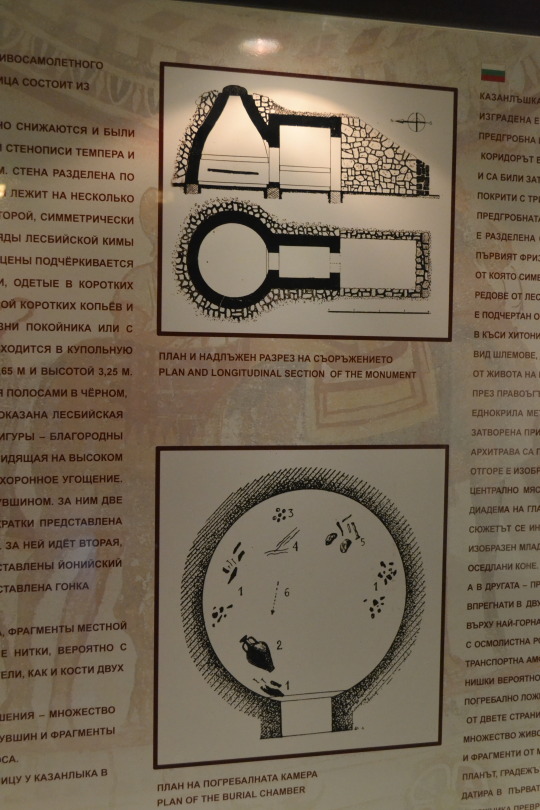

In Thrace, at least royal tombs are repurposed shrines (above: diagram and model of repurposed shrine-tombs). Macedonian Tombs were new construction meant to look like a shrine (faux-fronts, etc.). Also, Thracian kings’ bodies weren’t buried in their "tombs." Following the Dionysic/ Orphaic cult, the bodies were cut up into seven pieces and buried in unmarked spots. Ergo, their tombs are cenotaphs (below: Kosmatka Tomb/Tomb of Seuthes III, photos mine).


What they shared was putting absurd amounts of wealth into the ground in the way of grave goods, including some common/shared items such as armor, golden crowns, jewelry for women, etc. All this in place of community-reflective temples, as seen in the South. (Below: grave goods from Seuthes’ Tomb; grave goods from Royal Tomb II at Vergina, for comparison).



So, if some things are shared, others (connected to beliefs about the afterlife) are distinct, such as the repurposed shrine vs. new construction built like a shine, and the presence or absence of a body (below: tomb ceiling décor depicting Thracian deity Zalmoxis).

Aside from graves, we also find differences between highlands and lowlands in the roles of at least elite women. The highlands were tough areas to live, where herding (and raiding) dominated, and what agriculture there was required “all hands on deck” for survival. While that isn’t necessary for women to enjoy higher status (just look at Minoan Crete, Etruria, and even Egypt), it may have contributed to it in these circumstances.
Illyrian women fought. And not just with bows on horseback as Scythian women did. If we can believe Polyaenus, Philip’s daughter Kyanne (daughter of his Illyrian wife Audata) opposed an Illyrian queen on foot with spears—and won. Philip’s mother Eurydike involved herself in politics to keep her sons alive, but perhaps also as a result of cultural assumption: her mother was royal Lynkestian but her father was (perhaps) Illyrian. Epirote Olympias came to Pella expecting a certain amount of political influence that she, apparently, wasn’t given until Philip died. Alexander later observed that his mother had wisely traded places with Kleopatra, his sister, to rule in Epiros, because the Macedonians would never accept rule by a woman (implying the Epirotes would).
I’ve noted before that the political structure in northern Greece was more of a continuum: Thessaly had an oligarchic tetrarchy of four main clans, expunged by Jason in favor of tyranny, then restored by Philip. Epiros was ruled by a council who chose the “king” from the Aiakid clan until Alexandros I, Olympias’s brother, established a real monarchy. Last, we have Macedon, a true monarchy (apparently) from the beginning, but also centered on a clan (Argeads), with agreement/support from the elite Hetairoi class of kingmakers. Upper Macedonian cantons (formerly kingdoms) had similar clan rule, especially Lynkestis, Elimeia, and Orestis. Alas, we don’t know enough to say how absolute their monarchies were before Philip II absorbed them as new Macedonian districts, demoting their basileis (kings/princes) to mere governors.
I think continued highland resistance to that absorption is too often overlooked/minimized in modern histories of Philip’s reign, excepting a few like Ed Anson’s. In Dancing with the Lion: Rise, I touch on the possibility of highland rebellion bubbling up late in Philip’s reign but can’t say more without spoilers for the novel.
In antiquity, Thessaly was always considered Greek, as was (mostly) Epiros. But Macedonia’s Greek bona-fides were not universally accepted, resulting in the tale of Alexandros I’s entry into the Olympics—almost surely a fiction with no historical basis, fed to Herodotos after the Persian Wars. The tale’s goal, however, was to establish the Greekness of the ruling family, not of the Macedonian people, who were still considered barbaroi into the late Classical period. Recent linguistic studies suggest they did, indeed, speak a form of northern Greek, but the fact they were regarded as barbaroi in the ancient world is, I think instructive, even if not necessarily accurate.
It tells us they were different enough to be counted “not Greek” by some southern Greek poleis and politicians such as Demosthenes. Much of that was certainly opportunistic. But not all. The bias suggests Macedonian culture had enough overflow from their northern neighbors to appear sufficiently alien. Few Greek writers suggested the Thessalians or Epirotes weren’t Greek, but nobody argued the Thracians, Paiones, or Illyrians were. Macedonia occupied a liminal status.
We need to stop seeing these areas with hard borders and, instead, recognize permeable boundaries with the expected cultural overflow: out and in. Contra a lot of messaging in the late 1800s and early/mid-1900s, lifted from ancient narratives (and still visible today in ultra-national Greek narratives), the ancient Greeks did not go out to “civilize” their Eastern “Oriental” (and northern barbaroi) neighbors, exporting True Culture and Philosophy. (For more on these views, see my earlier post on “Alexander suffering from Conqueror’s Disease.”)
In fact, Greeks of the Late Iron Age (LIA)/Archaic Age absorbed a great deal of culture and ideas from those very “Oriental barbarians,” such as Lydia and Assyria. In art history, the LIA/Early Archaic Era is referred to as the “Orientalizing Period,” but it’s not just art. Take Greek medicine. It’s essentially Mesopotamian medicine with their religion buffed off. Greek philosophy developed on the islands along the Asia Minor coast, where Greeks regularly interacted with Lydians, Phoenicians, and eventually Persians; and also in Sicily and Southern Italy, where they were talking to Carthaginians and native Italic peoples, including Etruscans. Egypt also had an influence.
Philosophy and other cultural advances didn’t develop in the Greek heartland. The Greek COLONIES were the happenin’ places in the LIA/Archaic Era. Here we find the all-important ebb and flow of ideas with non-Greek peoples.
Artistic styles, foodstuffs, technology, even ideas and myths…all were shared (intentionally or not) via TRADE—especially at important emporia. Among the most significant of these LIA emporia was Methone, a Greek foundation on the Macedonian coast off the Thermaic Gulf (see map below). It provided contact between Phoenician/Euboian-Greek traders and the inland peoples, including what would have been the early Macedonian kingdom. Perhaps it was those very trade contacts that helped the Argeads expand their rule in the lowlands at the expense of Bottiaians, Almopes, Paionians, et al., who they ran out in order to subsume their lands.
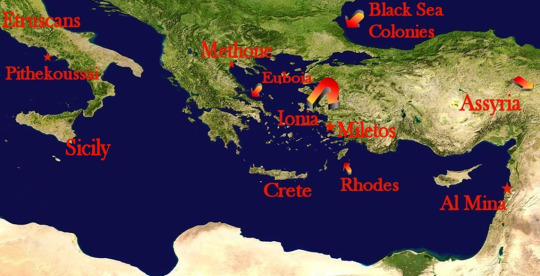
My main point is that the northern Greek mainland/southern Balkans were neither isolated nor culturally stunted. Not when you look at all that gold and other fine craftwork coming out of the ground in Archaic burials in the region. We’ve simply got to rethink prior notions of “primitive” peoples and cultures up there—notions based on southern Greek narratives that were both political and culturally hidebound, but that have, for too long, been taken as gospel truth.
Ancient Macedon did not “rise” with Philip II and Alexander the Great. If anything, the 40 years between the murder of Archelaos (399) and the start of Philip’s reign (359/8) represents a 2-3 generation eclipse. Alexandros I, Perdikkas II, and Archelaos were extremely capable kings. Philip represented a return to that savvy rule.
(If you can read German, let me highly recommend Sabine Müller’s, Perdikkas II and Die Argeaden; she also has one on Alexander, but those two talk about earlier periods, and especially her take on Perdikkas shows how clever he was. For those who can’t read German, the Lexicon of Argead Macedonia’s entry on Perdikkas is a boiled-down summary, by Sabine, of the main points in her book.)
Anyway…I got away a bit from Thracian-Macedonian cultural parallels, but I needed to mount my soapbox about the cultural vitality of pre-Philip Macedonia, some of which came from Greek cultural imports, but also from Thrace, Illyria, etc.
Ancient Macedonia was a crossroads. It would continue to be so into Roman imperial, Byzantine, and later periods with the arrival of subsequent populations (Gauls, Romans, Slavs, etc.) into the region.
That fruit salad with Cool Whip, or Jello and marshmallows, or chopped up veggies and mayo, that populate many a family reunion or church potluck spread? One name for it is a “Macedonian Salad”—but not because it’s from Macedonia. It’s called that because it’s made up of many [very different] things. Also, because French macedoine means cut-up vegetables, but the reference to Macedonia as a cultural mishmash is embedded in that.
---------------
* I’ve seen this personally between my first trip to Greece in 1997, and the new modern highway. Instead of winding around mountains, the A2 just blasts through them with tunnels. The A1 (from Thessaloniki to Athens) was there in ’97, and parts of the A2 east, but the new highway west through the Pindus makes a huge difference. It takes less than half the time now to drive from the area around Thessaloniki/Pella out to Ioannina (near ancient Dodona) in Epiros. Having seen the landscape, I can imagine the difficulties of such a trip in antiquity with unpaved roads (albeit perhaps at least graded). Taking carts over those hills would be daunting. See images below.

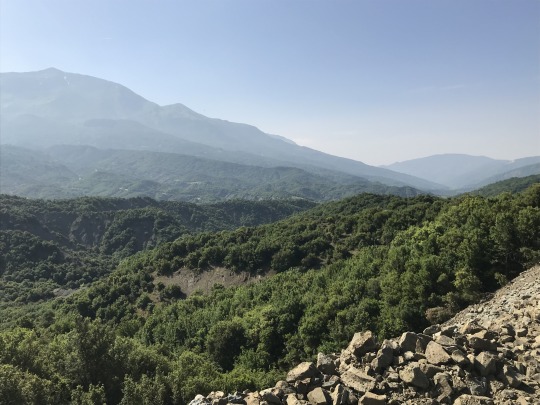
#asks#ancient Macedonia#ancient Thrace#ancient Epiros#ancient Thessaly#Argead Macedonia#pre-Philip Macedonia#Late Iron Age Greece#Archaic Age Greece#Thracian tombs#Macedonian tombs#Classics#tagamemnon#Alexander the Great#Philip II of Macedon#Philip of Macedon#women in ancient Macedonia#ancient Illyria#women in Illyria#Macedonian-Thracian similarities#religion in ancient Thrace#religion in ancient Macedonia
13 notes
·
View notes
Text
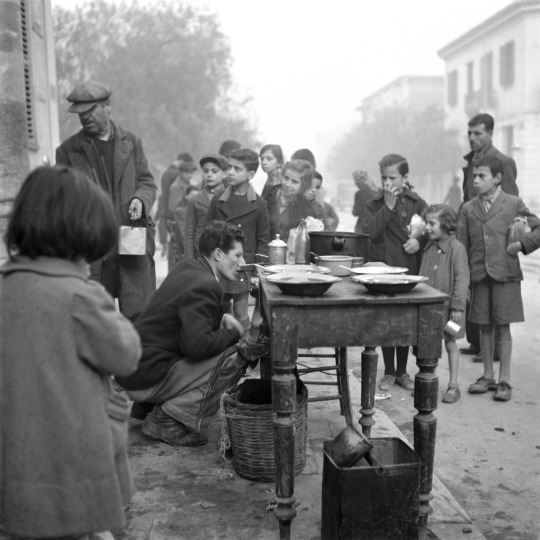
December 1941. In the days when people in Athens were dying of hunger, someone dreamed of food and cooking .
In February 1940, five months had already passed since the German invasion of Poland and the subsequent declaration by England and France of what was to be called World War II. It was the period that became known as the "Drôle de Guerre" (Drôle de Guerre), because, despite the official declaration of war, a portion of the belligerents had not yet mobilized all their forces for full engagement.
In Greece, life continued as normal and on the 2nd of the month, Elisavet Psilopoulou of Nikolaou, an employee of the State General Accounting Office, signed up as a subscriber "to the Apantas of the Ancient Authors", a series of 200 unbound volumes, "at a discounted price, i.e. for 30 drachmas "each volume" of Papyros publications. The very next day Miss Psilopoulou, Lisa to her friends, signs the relevant agreement for "a series of Ancient Authors, for a total price of 6,000 drachmas".
6 notes
·
View notes
Photo

I consider myself King of the Hellenes and sole expression of legality in my country until the Greek people freely decide otherwise. I fully expected that the military regime would depose me eventually. They are frightened of the Crown because it is a unifying force among the people.
- King Constantine II of the Hellenes
An important chapter of Greek history ended on 11 January 2023, in Athens, with a deafening silence. The former king Constantine II died at the age of 82 in Athens. Some Greek media outlets referred to him as Constantine Glücksburg, not wishing to mention the royal title of the former monarch who was deposed in 1974.
The last member of the Danish dynasty to rule from 1863 until the return of the Parliamentary Republic was the cousin of the British monarch Charles III and one of the godparents of his son, Prince William, and the brother of Queen Sofia of Spain. But his death caused barely a rustle in Greece, a country that has been riven by divisions between royalists and democrats since its creation.
He was not given the state funeral he had so much desired. Neither the Greek Prime Minister, Kyriakos Mitsotakis, nor the President of the Republic, Katerina Sakellaropoulou, were present at his funeral on 16 January. His death "marks the formal epilogue (...) of a chapter that was definitively closed with the 1974 referendum," when Greeks voted by 70% to abolish the monarchy, said the prime minister in a terse message of condolence. The conservative leader also recalled "the eventful journey of former King Constantine, marked and punctuated by turbulent moments in the contemporary history of Greece." "History now has the floor. It will judge fairly and severely the Constantine of public life," he concluded.

The legacy of King Constantine II of the Hellenes remains a mixed one and mirrors the divided feelings of Greeks have to this day about their last king.
In many ways, Constantine was a victim of the vicious political infighting that had characterised Greek politics and its society for much of the period since the second world war. It perhaps needed a stronger, more experienced and more resolute approach to surmount the crises of his three-year reign than the young man in his early 20s could manage. In later life he said in an interview that he might have liked to be an actor or a journalist, but his fate was to spend his life as an ex-king, harried by Greek politicians and in turn harassing them in a prolonged legal fight for compensation for his family’s lost property, eventually through the European court of human rights.
Born in Athens, Constantine was the son of the Greek crown prince, Paul, the younger brother of King George II, and his German-born wife Princess Frederica, and was taken into exile as a baby following the Italian and then Nazi invasions of the country in 1940-41. His early years were spent first in Egypt and then in South Africa, before the family returned to Greece following the referendum that restored George to the throne in 1946. George died the following year, and Paul became king.
Constantine was educated at a private high school in Athens, modelled on the same lines as the German educationist Kurt Hahn’s principles at Gordonstoun, and afterwards attended Athens University to study law. A keen sailor, Constantine was a member of Greece’s winning sailing team at the 1960 Rome Olympics – the country’s first gold medal in nearly 50 years.
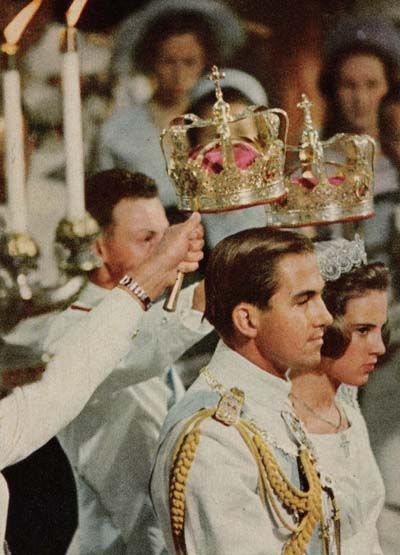
He succeeded to the throne aged 23 on his father’s death in March 1964, becoming head of state in a country that had not got over the civil war between communists and the Greek government of 1946-49, and where political tensions and divisions continued to run deep. The CIA, desperate to avoid Greece falling into communist hands, was also active in Athens. Greece was a strategic pawn between the US and the Soviet Union, each anxious to pull the country into its sphere of influence in the eastern Mediterranean. At the same time, it was attempting to modernise with social and economic reforms as an associate member and applicant to join the Common Market.
The month before Constantine came to the throne, a general election had produced a leftwing government under George Papandreou, following eleven years of rightwing government. Within a year, relations between the king and his prime minister were breaking down. Conservative army officers were alarmed by a perceived leftwards drift among the junior ranks, who were supported by Papandreou’s Harvard-educated son Andreas. When George Papandreou announced that he would take over the defence ministry himself, Constantine refused to allow him to do so, and the government resigned. In the hiatus that followed, the king attempted to appoint a government without holding an election and was accused of acting unconstitutionally.

When elections were finally called in April 1967, the likely re-election of Papandreou was forestalled by an army coup led by colonels. Constantine initially appeared to go along with the insurgents. He argued later that he had had no choice as the palace was surrounded by army tanks, but there were also persistent suggestions that he had been urged by the American embassy to do so in order to avoid another radical government. Many Greeks and civilian politicians never forgave the king for acceding to the coup, but within months he attempted a counter-coup of his own, fleeing to loyalist troops in the northern city of Kavala that December in an attempt to create a rival military support and force the junta to resign.
The operation was poorly organised and, although the air force and navy declared their support, the army and its officers rallied to the coup leaders. Support for the king melted away within 24 hours. Fearing bloodshed if it came to a military confrontation, Constantine and his family fled into exile, first in Rome and then a few years later in London.

There was no going back for the king. The junta, led by Colonel Georgios Papadopoulos, brutally consolidated their regime using censorship, mass arrests of opponents, torture and imprisonments, and were not going to reinstate Constantine after his attempted coup. When monarchist navy officers unsuccessfully attempted to overthrow the colonels in June 1973, Papadopoulos declared the country a republic, endorsed subsequently in a plebiscite widely assumed to have been rigged.
Nonetheless, when the regime fell following the Turkish invasion of Cyprus in 1974, to be succeeded by a civilian government, a further referendum was held to determine whether the king should be restored. Constantine was not allowed to return in order to campaign on his own behalf, though he was allowed to broadcast an address from London in which he apologised for his previous errors. But his maladroit interference with the civilian governments before the coup was held against him and the outcome of the vote in December 1974 was heavily in favour of a republic: by 69% to 31%.

Thereafter, for decades, Constantine was prevented from visiting Greece except briefly and on rare occasions: for his mother’s funeral in 1981 and for an attempted holiday in 1993, when he found his yacht was constantly harried by torpedo boats and aeroplanes. The following year, the Greek government revoked his citizenship and passport and seized the royal family’s property. “The law basically said that I had to go out and acquire a name. The problem is that my family originates from Denmark and the Danish royal family haven’t got a surname,” he said, adding that Glücksburg was the name of a place not a family: “I might as well call myself Mr Kensington.”
In 2000, the court of human rights found for the king in relation to the property, though it could only order compensation, not the return of his extensive estates nor the royal palace at Tatoi and awarded him only 12m euros (around £10m), rather than the 500m he had asked for: a reduction that the Greek government counted as a triumphant vindication. It nevertheless took another two years to pay the money and, when it did so, the government took it from its extraordinary natural disasters fund rather than general reserves. In retaliation, Constantine used the money to set up a charitable foundation in the name of his wife to assist Greeks suffering from natural disasters. He said: “I feel the Greek government have acted unjustly and vindictively. They treat me sometimes as if I am their enemy – I am not the enemy. I consider it the greatest insult in the world for a Greek to be told he is not a Greek.”

Generally, while expressing a wish to be allowed to live in Greece, which was granted in 2013, Constantine seemed equable about his fate and did not attempt to regain the throne. “All I want is to have my home back and to be able to travel in and out of Greece like every other Greek. I don’t have to be in Greece as head of state. I am quite happy to be there as a private citizen,” he told the news media in 2000. “Forget the past, we are a republic now. Let’s get on with the future.”
By the standards of the hapless Greek monarchy, Constantine II, the last king of the Hellenes, who died aged 82 on 10 January 2023, led a comfortable life in exile after a brief and turbulent reign. Of the seven Greek monarchs of the 19th and 20th centuries, three were deposed, one assassinated, two abdicated and one died of septicaemia after being bitten by a barbary ape in the royal gardens.
The Glücksburg monarchy was German-Danish in origin, imposed on Greece in the 1830s. During prolonged wrangling after Constantine’s deposition, the Greek government refused to give him a passport until he acknowledged that he was Mr Glücksburg, whereas he insisted he was just plain Constantine. As the last of Greece’s deposed monarchs he escaped lightly. But decades of exile in London, as one thing the Greeks did not want back from Britain, were not how he would have chosen to spend his life. For more than 20 years he was careful not to stir up anti-monarchist feeling in Greece, though he never relinquished his claim to the throne.

But Greeks have long memories. When the Greek colonels seized power in 1967, instigating seven years of tyranny, it was King Constantine who tried to stand up to them and rally the forces of democracy; but he did so rather naively and feebly.
Had Constantine succeeded, as did his brother-in-law Juan Carlos of Spain, he might have been a hero to his people. As it was, in the eyes of many Greeks, he remained tainted by family history and by his own clumsy mishandling of the political crisis that had brought about his exile. It’s a mistake he has freely acknowledged during the long 46 years of exile from his homeland.
There are Greeks still today who have always felt the referendum to depose him as King was rigged. For his part, Constantine, always continued to support democracy and the republic. Except with one caveat. According to many, Constantine never accepted his deposition. His Danish diplomatic passport still read "Constantine, King of Greece." In an interview with the television channel Skai in 2016, he even said: "I am not the former King Constantine, I am King Constantine, period."
In public at least, his fidelity to the republic bore fruit when he was allowed to come back to Greece and reside there. By all accounts his return from exile was a happy one where his home in Peloponnese coast gave him the peace he so long craved to live and eventually die in his own homeland. "All Greeks who live in exile want to return. It's in their blood," And so he got his wish. He was buried as a Greek, if not as a king.
RIP King Constantine II of the Hellenes (1940-2023)
#king constantine II of the hellenes#constantine II#greece#quote#royalty#monarchy#history#politics#coup#exile#king constantine II of greece
45 notes
·
View notes
Text
Voluntarios de la tierra de Israel en una pausa del entrenamiento para zapadores en Ranworth, Escocia, julio de 1940

Tras el estallido de la Segunda Guerra Mundial, judíos de la tierra de Israel, como ciudadanos del Imperio Británico, se unieron al ejército británico. Fueron trasladados a Inglaterra y Escocia para recibir instrucción militar; alrededor de 2.500 se incorporaron a los Zapadores Militares Auxiliares en julio de 1940, en Ranworth, Escocia. Jaim Weizmann, presidente de la Organización Sionista Mundial, ofreció la cooperación del Yishuv, la comunidad judía de la tierra de Israel, al esfuerzo bélico británico. Aunque inicialmente los británicos rechazaron la idea de una fuerza combatiente judía, a mediados de 1940 aceptaron formar regimientos de infantería, artillería antiaérea y costera, con la esperanza de ganarse el apoyo estadounidense. En septiembre de 1940, algunos regimientos de judíos palestinenses fueron formados, y en octubre de 1940 se decidió crear una fuerza de combate del tamaño de una brigada, con oficiales del Yishuv para mantener el carácter sionista. En abril de 1941, 1.500 soldados judíos de Palestina fueron capturados por los alemanes durante la invasión de Grecia. Debido al temor por la reacción árabe, el plan fue pospuesto, pero en 1944 se formó la Brigada Judía, en la que sirvieron 5.000 judíos de la tierra de Israel. En total, 30.000 judíos de Eretz Israel se alistaron en el ejército británico, incluidos aquellos que huyeron de Europa a fines de los 1930 por la amenaza nazi.

After the outbreak of World War II, Jews from the Land of Israel, as British Empire citizens, enlisted in the British Army. They were transferred to England and Scotland for military training; around 2,500 of them joined the Auxiliary Military Pioneer Corps in July 1940, in Ranworth, Scotland. Chaim Weizmann, president of the World Zionist Organization, offered the support of the Yishuv, the Jewish community of the Land of Israel, to the British war effort. Although the British initially rejected the idea of a Jewish combat force, they agreed to form infantry regiments, anti-aircraft, and coastal artillery units in mid-1940, hoping to gain American support. In September 1940, some Palestinian Jewish regiments were formed, and in October 1940, a decision was made to create a combat force the size of a brigade, with officers from the Yishuv to ensure its Zionist character. In April 1941, 1,500 Jewish soldiers from Palestine were captured by the Germans during the invasion of Greece. Due to concerns over Arab reaction, the plan was postponed, but by 1944, the Jewish Brigade, with 5,000 Jews from the Land of Israel serving, was formed. In total, 30,000 Jews from Eretz Israel enlisted in the British Army, including those who fled Europe in the late 1930s due to the Nazi threat.
#segunda guerra mundia#judíosjudaísmo#israel#yishuv#palestina#grecia#eretz israel#ejército británico#amenaza nazi#europa#sionismo#zionism#inglaterra#escocia#world war ii#world war 2#julio 1940#july 1940#1940#judaísmo#judaism#jewish#judío#historia judía#jewish history
2 notes
·
View notes